
Find anything, super fast.
- Destinations
- Documentaries

Eclipse Specifications
- Name Eclipse
- Model Custom
- Flag Bermuda
- Class Lloyds Register
- Hull NB 978
- Hull Colour -
- Naval Architect Blohm + Voss
- Exterior Designer Terence Disdale
- Interior Designer Terence Disdale
- Length Overall 162.5m
- Length at Waterline -
- Draft (min) -
- Draft (max) 5.9m
- Gross Tonnage 13000
- Cabins Total 18
- Cabins 1 Master / 17 VIP
- Hull Configuration Displacement
- Hull Material Steel
- Superstructure -
- Deck Material -
- Fuel Type Diesel
- Manufacturer -
- Model 20V 1163 TB93
- Total Power -
- Propulsion Triple Screw
- Max Speed 25 Kn
- Cruising Speed 22 Kn
- Fuel Capacity -
- Water Capacity -
- Generator -
- Stabilizers -
- Thrusters -
- Amenities -
- Yacht Builder Blohm + Voss No profile available
- Naval Architect Blohm + Voss No profile available
- Exterior Designer Terence Disdale View profile
- Interior Designer Terence Disdale View profile
Yacht Specs
Other blohm + voss yachts, related news.
Roman Abramovich just spent a mind-boggling $2.2 million to fuel up his $600 million superyacht – Longer than 5 football fields, the Eclipse has anti-missile systems, a laser shield, two helipads, and its very own submarine.
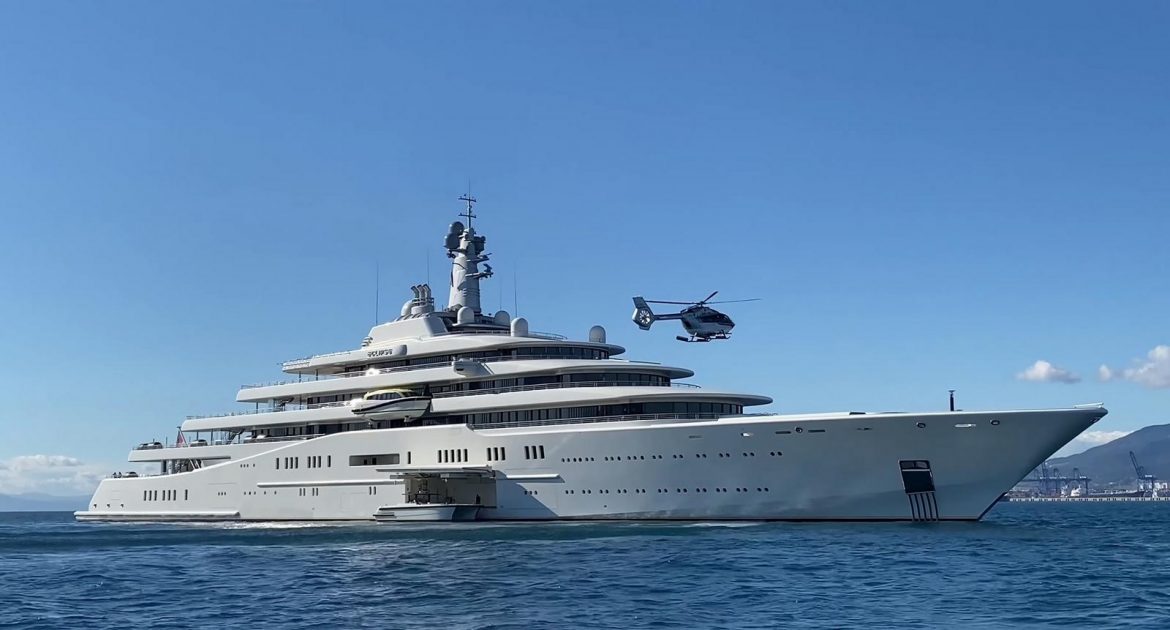
You may also like
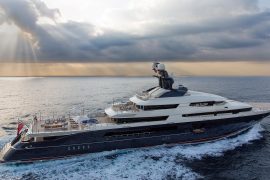
Not from an oligarch, but the first ever superyacht seized by the FBI was this $250 million vessel belonging to a friend of Leonardo Di Caprio – The 300-feet long yacht has gold leaf and marble interiors, a spectacular spa, a movie theater, and a 66-feet long swimming pool.
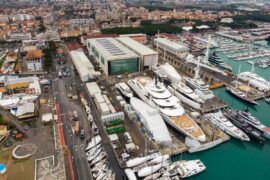
Maintaining the seized superyachts is becoming a huge problem for Italy, from scraping the hulls of the mammoth vessels daily to constantly running the air-conditioning units to paying the crew. Officials are now worried that these costs may exceed the value of the vessels.
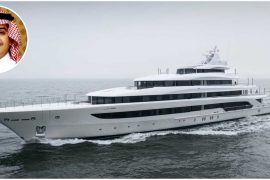
The shipyard that built Jeff Bezos’ megayacht has completely transformed this Saudi billionaire’s $100 million superyacht. He got his vessel extended by 10 meters to include a 23-foot-long infinity pool, a beach club, a climate-controlled winter garden, & a lot more.
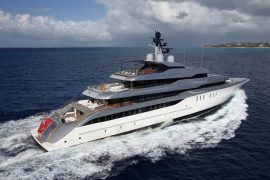
While France and Spain enthusiastically seized luxury yachts worth billions, they are now asking their sanctioned oligarch owners for money to maintain their arrested vessels.

At $620 million, Project Azzam will dwarf Roman Abramovich’s yatch
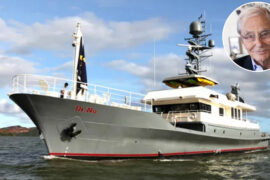
The late American billionaire, who funded Google and Amazon in their early days, owned the ‘Dr No’ yacht. Originally a fisheries training ship, the vessel was tastefully converted into a luxury explorer vessel, featuring a diving center, a submarine, and a lavish master suite.
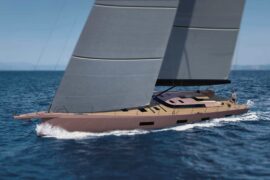
The Barbie mania continues: Baltic Yachts has announced an 80-foot-long sailing yacht in pastel pink.

While Roman Abramovich may be pleading with his rich friends for money now – Back in the day he casually spent $55,000 just to fly sushi from his favorite London restaurant in a private jet for himself and his friends in Azerbaijan.
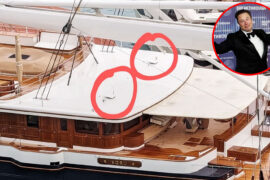
While Jeff Bezos is spending billions to launch his own satellite internet service to compete with Elon Musk, his own $500 million megayacht Koru openly flaunts antennas from Musk’s Starlink.

World’s First Commercial-Use Ammonia-Fueled Vessel Receives ClassNK Certification

China’s Largest Ports Set To Establish Green Shipping Corridors

French Navy Destroys Bomb-Carrying Drone Boat & Rescues 29 Crew From Attacked Oil Tanker In Red Sea

Houthi-Hit Oil Tanker Carrying 1,50,000 Tonnes Of Crude Poses Environmental Risk In Red Sea

Eclipse – The World’s Most Expensive Private Yacht
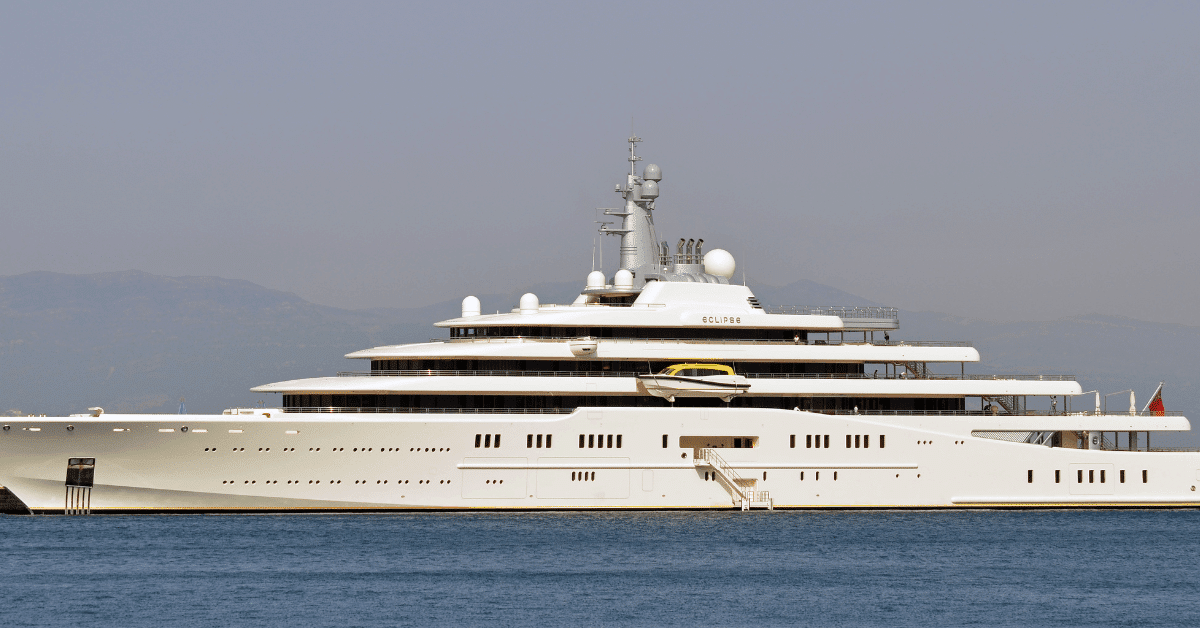
In the world of soccer, Roman Abramovich is a popular figure as he owns the leading English club, Chelsea. The Russian businessman helped the Blues become a big spender in the transfer market, bringing brilliant players like Arjen Robben, Didier Drogba, Fernando Torres, etc. to offer the beautiful game to club supporters across the world.
In addition to the Chelsea football team, which is a beauty on soccer fields, Abramovich owns another marvel: a private yacht named Eclipse.
The 162.5m-long beauty Eclipse is the world’s second-largest and one of the most expensive superyachts. Its estimated cost is 590 million (€340 million), and its current owner has owned it since December 2010.
A synonym for luxury, this superyacht is best suited for all adventure and water sports activities and provides splendid trips to cultural and historical destinations.
Built by renowned German shipbuilder Blohm + Voss, the Eclipse was launched in June 2009 after five years of design, development, and testing. Before its final delivery, several sea trials were conducted starting in May 2009 at Kristiansand, Norway.
When delivered, Eclipse won the spot for the largest superyacht in the world, beating the 162m-long M/Y Dubai of Mohammed bin Rashid Al Maktoum, the Prime Minister of the United Arab Emirates. Eclipse retained the title until the arrival of the 180m-long Azzam, UAE President Khalifa bin Zayed bin Sultan Al Nahyan’s private yacht in 2013. Currently managed by Blue Ocean Yacht Management, Eclipse was selected as the Motor Yacht of the Year in 2011 at the World Superyacht Awards.
Specifications of Eclipse Yacht
As mentioned earlier, this tremendous superyacht measures 162.5m (533’1″ft) in length, 22.00m (72’2″ft) in width and 5.90m (19’4″ft) in the draft, offering a vast area for luxurious leisure activities. The Bermuda-flagged Lloyds Register class yacht has a Gross Tonnage of 13000 tonnes.
Eclipse is powered by a diesel-electric, dual propulsion system with four MTU 20V 1163 TB93 marine diesel engines, offering the latest propulsion technology for maximum speed performance. These engines power the rotating Azipod drives, giving the yacht a maximum speed of 25 knots and a cruise speed of 22. Featuring 1,000,000 litres of fuel tanks, Eclipse can travel up to 6,000 nautical miles at 21 knots before refuelling. The boat also can store about 150,000 litres of freshwater abroad.
Interior and Exterior Design
While Blohm + Voss provided the naval architecture, Terence Disdale Design carried out the superstructure design of the Eclipse. The UK-based award-winning firm was also responsible for interior design, deck layouts, and construction supervision.
Incidentally, the vessel’s construction was performed with great secrecy, and due to this reason, the project was named Project Luxury Yacht M 147 throughout the construction period. However, the details of the technical design and construction of the yacht have not been revealed to the public; the design and layout are available for people to marvel at.
Divided into nine decks, the top deck of Eclipse is taken up by the helicopters and garage. The swimming pool and sundeck go on level eight, while level seven features a pool, atrium and an open deck. The salon, main dining hall and a 40ft X 60ft full-beam loggia are located on the sixth level, and the fourth floor features the main entrance of the yacht. While the next level of the yacht divides the cabins and suites of the owner, guests and crew, the second deck of the vessel acts as a docking port for the submarine. Level one accommodates the engine room, machinery, and a small disco club.
The superyacht with a displacement steel hull has an aluminium superstructure, while its decks become magnificent, featuring teak woods. To offer a smooth cruising experience, the yacht features an ultra-modern stabilization system that minimises the roll motion effect and is equipped with ‘at anchor stabilisers’ to increase comfort when the boat is stationary. Featuring the Art Deco interior design, with an innovative, technology-rich environment and the use of soft metallic fabrics, Eclipse offers a splendid living experience for its owner. With diverse facilities across the decks, the yacht meets the optimum standard of offering a leisure time platform.
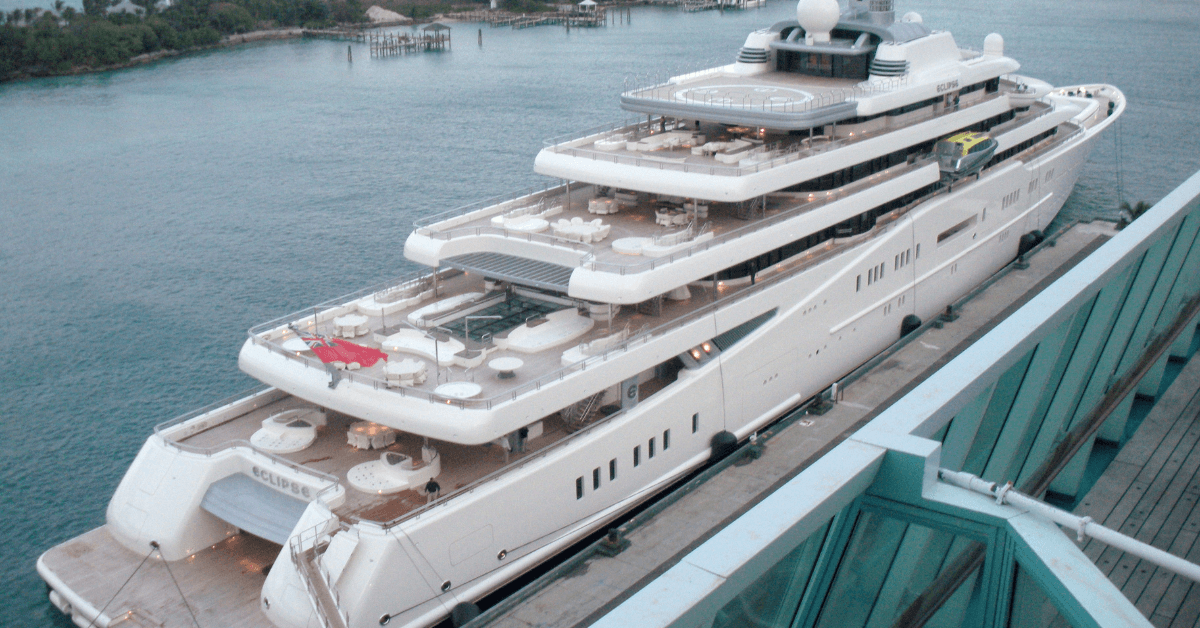
The entire yacht has been bejewelled with features to make it more luxurious. Spread across many decks, Eclipse facilities abroad include a gym, dance floor, underwater lights, beach club, wifi connection, beauty salon, tender, garage, deck jacuzzi, etc. Further, the Eclipse holds two helipads and a 16 m swimming pool that can be converted into a dance floor. This motor yacht can accommodate three helicopters, two on both helipads and the third one in a storage hangar below the foredeck. Moreover, Eclipse also flaunts internal lifts, six tenders and an exterior fireplace on-board. The boat also features a place for a three-person private submarine that can go up to a depth of 160ft.
Eclipse is also one of the most technologically advanced yachts around the world. The boat boasts the latest technology safety features, including motion sensors, bulletproof glass and antiballistic missile defence. In fact, each cabin in the yacht comes with a private 6ft home cinema screen, a Jacuzzi, a spa and specialized security systems. According to reports, Eclipse has an anti-paparazzi system that detects the use of digital cameras to click photographs of the boat. Using lasers, the system detects digital cameras and disrupts a potential picture of the yacht, as those infrared lights can make it unstable.
Accommodation
The yacht has 11 staterooms and suites, totalling 6000 square feet. With this facility, Eclipse can house 30 guests and a 92-member staff crew abroad. The master suite, located on level five of the yacht, is 5000 square feet alone. In addition, the boat also has a pilothouse on level seven.
With all these facilities incorporated, maintaining the Eclipse is not a less expensive matter. An annual expense of over $60 million is reportedly required to maintain this luxury boat. According to media reports, Abramovich charges its customers around £ 175,000 to rent the vessel for a day.
You may also like to read –
- Top 10 Books on Yacht Design
- The Awe-Inspiring Adastra Superyacht
Disclaimer : The information contained in this website is for general information purposes only. While we endeavour to keep the information up to date and correct, we make no representations or warranties of any kind, express or implied, about the completeness, accuracy, reliability, suitability or availability with respect to the website or the information, products, services, or related graphics contained on the website for any purpose. Any reliance you place on such information is therefore strictly at your own risk.
In no event will we be liable for any loss or damage including without limitation, indirect or consequential loss or damage, or any loss or damage whatsoever arising from loss of data or profits arising out of, or in connection with, the use of this website.

Do you have info to share with us ? Suggest a correction

About Author
Raunek Kantharia is a marine engineer turned maritime writer and entrepreneur. After a brief stint at the sea, he founded Marine Insight in 2010. Apart from managing Marine Insight, he also writes for a number of maritime magazines and websites.
Read More Articles By This Author >
Daily Maritime News, Straight To Your Inbox
Sign Up To Get Daily Newsletters
Join over 60k+ people who read our daily newsletters
By subscribing, you agree to our Privacy Policy and may receive occasional deal communications; you can unsubscribe anytime.

BE THE FIRST TO COMMENT
Leave a reply.
Your email address will not be published. Required fields are marked *
Subscribe to Marine Insight Daily Newsletter
" * " indicates required fields
Marine Engineering
Marine Engine Air Compressor Marine Boiler Oily Water Separator Marine Electrical Ship Generator Ship Stabilizer
Nautical Science
Mooring Bridge Watchkeeping Ship Manoeuvring Nautical Charts Anchoring Nautical Equipment Shipboard Guidelines
Explore
Free Maritime eBooks Premium Maritime eBooks Marine Safety Financial Planning Marine Careers Maritime Law Ship Dry Dock
Shipping News Maritime Reports Videos Maritime Piracy Offshore Safety Of Life At Sea (SOLAS) MARPOL
Take a closer look at Russian oligarch's $700 million superyacht that is one of the largest in the world
- Roman Abramovich had seemingly scrambled to avoid sanctions from the UK by moving his superyachts.
- One of those is The Eclipse, which cost $700 million to build and was once the biggest in the world.
- That yacht was once in New York City and we took some photos.

Like other Russian oligarchs, Roman Abramovich had seemingly scrambled to avoid sanctions and that included quickly moving his superyachts to more friendly waters.
Many of the 55-year-old billionaire's assets — such as the Chelsea Football Club and several homes — have been sold or frozen since Russia launched an unprovoked war on Ukraine, Bloomberg reported .
While Abramovich couldn't move the Premier League football club Chelsea FC and sold the $3 billion club , his yachts are another matter.
Abramovich's 553-foot-long flagship is The Eclipse, estimated to have cost $700 million when built. After sanctions were initially dropped by the UK against Abramovich, his second "smaller" $600 million superyacht, Solaris, left Barcelona, Spain, and moved to friendlier waters in Turkey.
Solaris was joined in Turkey by The Eclipse, which arrived from the Caribbean .
While the superyacht Eclipse was photographed in Turkish waters in early August , it was once docked at Manhattan's Pier 90, and Robert Johnson was able to get some pictures. Take a tour of the superyacht below.
Robert Johnson contributed to this post.
Just south of this public parking lot on the roof of the Pier 90 terminal in New York City sat Russian billionaire Roman Abramovich's flagship yacht, the "Eclipse."
536-feet long and styled after military vessels.
The 2010 Eclipse cost $700 million and was the world's largest yacht when built.
The vessel has amenities to rival any ship on the sea — like its own mini submersible, perhaps similar to this— able to dive down 150-feet.
The Eclipse has two helipads.
Bulletproof glass and armor plates wrap the length of Roman's master suite and the bridge.
And a German-built missile defense system.
The ship's also supposed to have a laser defense against paparazzi trying to photograph the yacht's guests, but saw no evidence of the device when we were there.
The Eclipse has three launch boats.
That looked to be stocked with medical supplies and a variety of handheld radios.
From the cruise ship parking lot it felt like we were almost on the Eclipse itself.
But with little chance we'd be invited aboard through the ship's door here ...
... We hoped to find one of the 70 crew members required to sail the Eclipse and see if they'd tell us what ship life was like.
But we found no one interested in talking.
But we certainly didn't feel like paparazzi, or that we'd be lasered, when we were in the parking lot tourists use when they arrive to board their cruise.
From up here, the ship was simply stunning and the amount of work required to keep her that way apparent.
The Yacht Report says owning a superyacht costs about 20% of the ship's initial value every year.
But experts believe that Roman probably pays $75 million a year to run the private cruise ship with 24-guest suites.
Looking at the layout of the ship gets us talking about the two swimming pools inside, the disco, cinema, hair salon, and restaurant.
The billionaire's guests would use this door to enter any fore part of the deck.
Perhaps noting where the life rings were as they made their way about the ship.
At 13,000 gross tons, the Eclipse was, at the time, the largest vessel to use a special stabilization system to keep it calm in rough waters while anchored or moving slowly through the sea.
Roman faced a $150,000 tab for parking the Eclipse in New York City while possibly visiting his daughter and her new baby — about $2,000 a day.
A large yacht like the Eclipse can hold over 100,000 gallons of fuel.
Depending on the current price of fuel, a five-hour cruise each way could cost about $30,000.
None of those numbers are likely to concern Roman Abramovich, however, who has an estimated net worth of nearly $8 billion.
Source: Forbes
Here is some drone footage of the superyacht.
You can see interior photos of the luxury yacht at Boat International
Step on board the 162.5m Eclipse - the second largest superyacht in the world
- Main content

Eclipse Yacht: The World’s Most Expensive Private Yacht ($1.5 Billion)
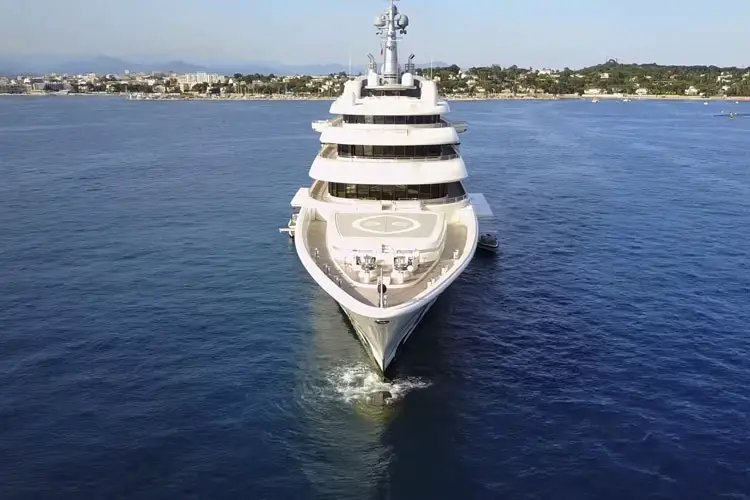
Eclipse Yacht Facts
Yacht Name: Eclipse Yacht Length: 162 m (533 ft) Guests: 36 in 18 cabins Crew: up to 96 Displacement: 13,564t Builder: Blohm & Voss Year:- 2010 Yacht Cost: US$ 590 million Yacht Current Value: USD $1.5 Billion Yacht Owner: Roman Abramovich
Some of the most expensive boats in the world are yachts . Yachts are a sign of extreme wealth and luxury. And the $1.5 Billion Eclipse is the best of the best! It is the most expensive private yacht in the world and owned by the super glamorous Russian billionaire businessman – Roman Abramovich.
This article discusses the world’s most expensive private yacht, who owns it, the luxuries that it holds, and how it functions.
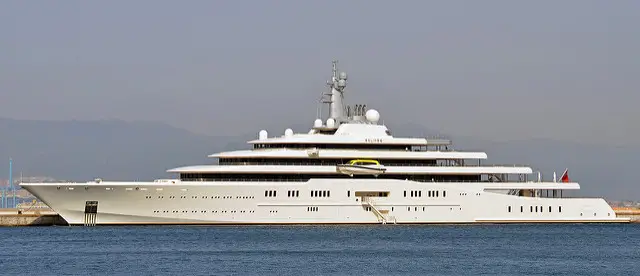
Following are some interesting facts about the world’s most expensive private yacht ‘Eclipse’
What it is and who owns it.
Eclipse which has the full name of M/Y Eclipse is a luxury motor yacht. A Russian businessman named Roman Abramovich owns it. He is the 11th richest person in Russia and the 140th richest person in the world. He is best known as the owner of the Chelsea Football Club. Chelsea FC is a premier league football club which is famous all over the world.
Abramovich has a net worth of 11.5 billion dollars. What is not known that popularly about him is that he is the owner of the world’s most luxurious and expensive private yacht.
Eclipse was delivered to Abramovich in December of 2010. It was built in Germany by a Hamburg-based company called Blohm-Voss. Eclipse is the world’s most expensive yacht with an estimated cost of 340 million euros or 590 million dollars.
About the Yacht Eclipse
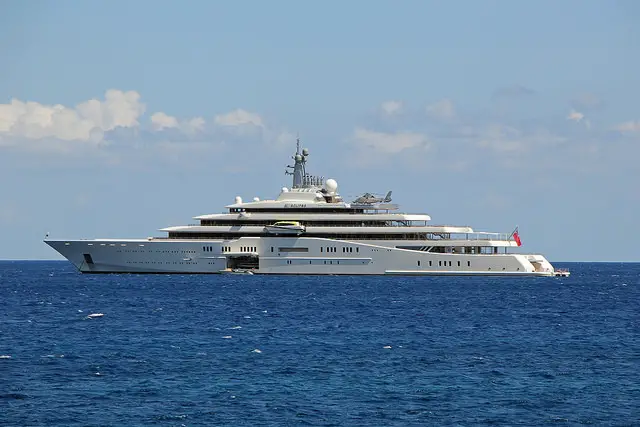
The yacht is a total of 162.5 m in length and 22 m in width. It has a draft of 5.90 m. This makes it the second-largest yacht in the world. It provides a lot of space for leisurely activities, is suitable for almost all adventure and water sports, and is also capable of offering trips to several cultural and historical destinations all over the world. It has several features.
It is interesting to know that the yacht eclipse also has two helicopter pads on it. There are 24 guest cabins, several hot tubs, a disco hall, and even two swimming pools. It also contains a gym, a dance floor, underwater lights, a Beach club, a beauty salon, a Wi-Fi connection, a tender garage, and a deck jacuzzi. The swimming pools on the yacht can be converted into a dance floor. Even though the yacht has two helicopter pads, it can accommodate three helicopters as it has one storage hanger below the foredeck. There is also an exterior fireplace on board the yacht.
Eclipse is also a very technologically advanced boat. It has the latest technology features like motion sensors, anti-ballistic missile defense, and bulletproof glass.
As stated, before it has 24 guest cabins. Each of these cabins has a private 6 feet home cinema screen, a spa, a jacuzzi, and specialized security systems. It is believed that the boat also has an anti-paparazzi system. The system can detect the use of digital cameras for taking pictures of the boat. It is capable of disrupting a potential photograph of the yacht using infrared lights with the help of lasers.
The yacht is also equipped with three launch boats. It also has a mini-submarine which can submerge up to 50 m or 160 feet underwater. The yacht requires about 70 crew members for its proper operation and to serve the guests.
The yacht is also equipped with a missile detection system for security.
It has also employed a rotor-based stabilization system. It works against roll motion at anchor and low cruise speeds. It is based on the Magnus effect. Eclipse is the largest vessel in the world to have employed such a system.
The yacht is a Bermuda Flagged, Lloyd Register class yacht. It has a gross tonnage of 13,000 tonnes. The yacht offers the latest technology for propulsion and maximum speed performance. It also has an installed diesel-electric dual propulsion system with four MTU 20V 1163 TB93 marine diesel engines.
Also read: The Mysteries Of The Bermuda Triangle
The yacht can attain a maximum speed of 25 knots and a cruise speed of up to 22 knots. It also can carry 1 million liters of fuel in tanks and can travel up to 6000 nautical miles at the rate of about 21 knots before it needs to be refueled. The boat can also store nearly one fifty thousand liters of fresh water on board.
The submarine of the yacht can accommodate up to three people and can go as deep as 160 feet underwater, as previously stated.
The boat has a total living area of 6000 square feet. There are 11 staterooms and suites on it. It can accommodate up to 30 guests and a crew of 96 staff members. Out of the 6000 square feet of area, the master suite alone is spread over 5000 square feet. On the seventh level of the boat, there is a pilothouse.
Being a boat with so many features, one can only imagine what the cost of the maintenance of it would be. As one would expect, the maintenance of the Eclipse is costly.
According to a report, the yacht requires more than 60 million dollars for maintenance every year. The per-day rent of the boat is around 175,000 pounds.
History of the Eclipse Yacht
As mentioned before the yacht is owned by Roman Abramovich, a Russian businessman. Eclipse was delivered to Abramovich in December of 2010. It was built in Germany by a Hamburg-based company called Blohm-Voss.
The yacht arrived for sea trials at Frederikshavn in Denmark in September 2009. The first-ever pictures of the boat were taken on 9 December 2010.
Terence Disdale Design carried out the superstructure design of the yacht. The same company was responsible for the interior designing of the yacht, layouts of the deck as well as supervision during its construction.
This yacht was constructed in great secrecy. At the time of construction, it was known as Project Luxury Yacht M 147 for the same reason. The details of the technical designs and construction of the boat have still not been revealed to the public. The only thing that is accessible to the public is the design layout.
Similar Posts
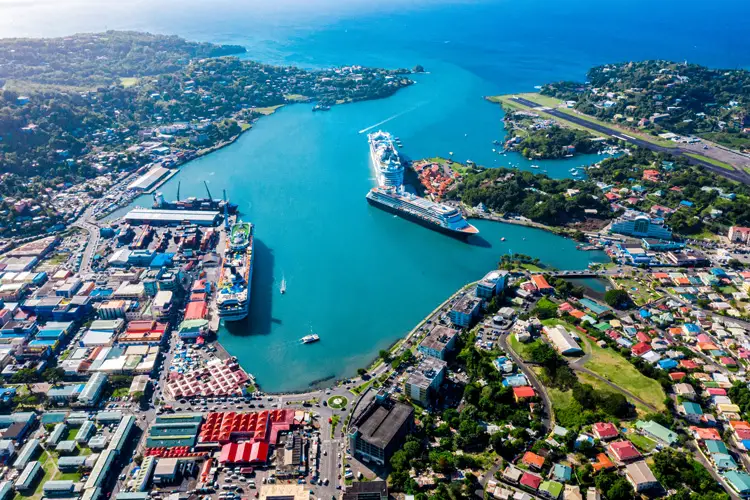
Outer Port Limit: Definition & Importance
Outer Port limit (OPL) is the limit of a port’s jurisdiction or control in a harbor or coastal area. Ports often have defined areas within which they exercise authority and provide services to ships entering or departing the port. The outer port limit could mark the boundary beyond which ships are considered to be in…
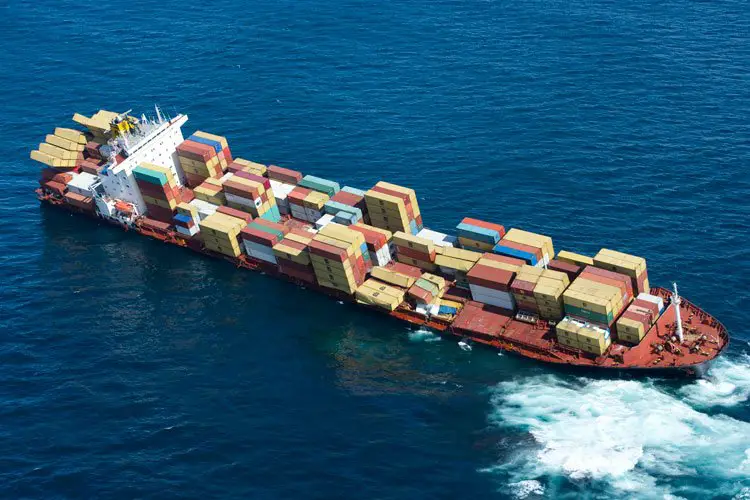
What is Marine Insurance? Types & Policies
What is Marine Insurance? According to Marine Insurance Act, 1906: “An agreement whereby the insurer undertakes to indemnify the assured, in the manner and to the extent thereby agreed, against incidental to marine adventure. It may cover loss or damage to vessels, cargo or freight.” Marine insurance is a type of insurance that provides compensation…
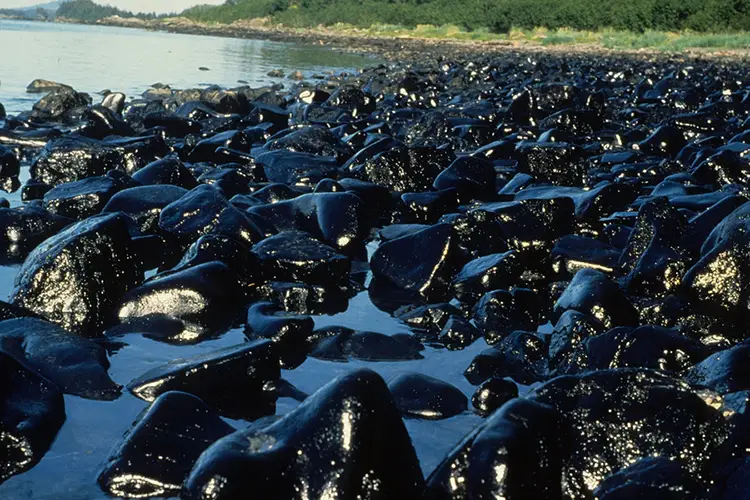
The Exxon Valdez Oil Spill Incident
Exxon Valdez oil spill was one of the worst accidents involving ocean oil spill. Today, we will uncover the true story behind it. The indispensability of oil in our day-to-day lives is unquestionable. The number of industries that are heavily reliant on oil as their source of fuel is vast. But what comes as a…
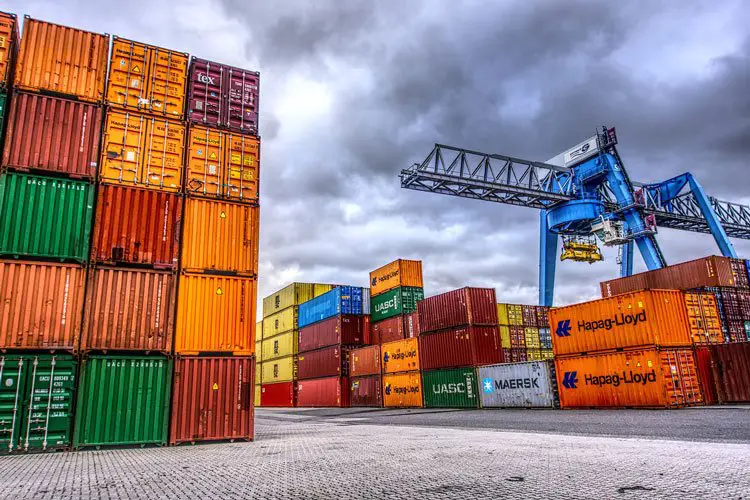
Top Container Terminal Operators in the World
Container terminals are very vital in this maritime industry as many facilities are being provided at the terminals and most of the part of the shipping can be done at the container terminals like packaging, loading-unloading, storing containers for some time and repair. Hence management and operating of these container terminals is a challenging job….
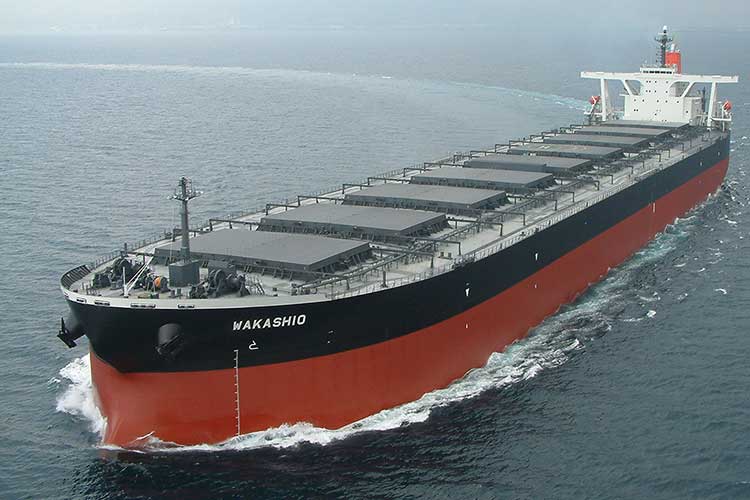
What Are Bulk Carriers?
What Are Bulk Carriers? Bulk carriers, as the name suggests, are the kinds of ships that are used to transport bulk cargoes over large distances. They are also called as bulk freighters or bulkers. They are merchant ships and usually contain cargo such as coal, cement, ore, grains, sugar, or any other material which is…
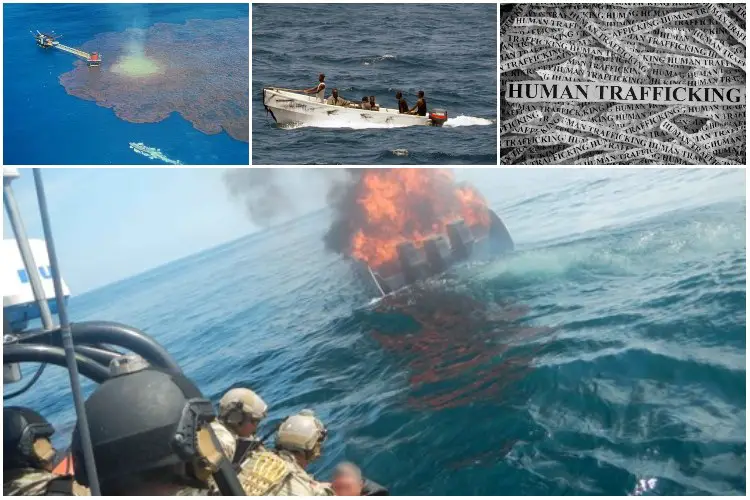
Different Types Of Maritime Crimes
A maritime crime is defined as any criminal activity carried out at sea. These criminal activities can be directed at vessels, could violate international laws or coastal state’s sovereignty, or simply be the use of sea vessels for illegal activities. Maritime crimes are a major setback for the marine industry as almost 80% of the…
Leave a Reply Cancel reply
Your email address will not be published. Required fields are marked *
Save my name, email, and website in this browser for the next time I comment.
This website uses cookies to improve your experience. We'll assume you're ok with this, but you can opt-out if you wish. Read More
Boat Reviews
- Boats Specs
- Marine Pros
- Boat Insurance
- Boat Warranties
- Boat Transport
- Boat Towing
- Marine Forecasts

Your Ultimate Boating Resource

Eclipse Yachts
- 1997 Eclipse 39 TR SF
- 1996 Eclipse 39 TR SF
- 1995 Eclipse 39 TR SF
- 1994 Eclipse 38 TR SF
- 1993 Eclipse 38 TR SF
Overview of the 2024 Sea-Doo RXP-X 325
Overview of the 2024 parker offshore 2900 cc, what your boat’s beam is and why it matters, power cats of 2024: ultimate guide to the top power catamarans this year, navigating the heat: 10 safety tips for a safe boat ride in the summer heat, what type of wood is used for pier pilings, what is the difference between a dock and a floating pier, what is the proper technique for pulling a beginner wakeboarder, what does ‘no wake’ mean on a lake, what is the difference between wash and wake, highs, lows, and tidal know-how: a deep dive into ocean currents, 10 essential tips for fishing near private property, the benefits of using a drift sock: guidance for anglers, lure fishing: secrets for imitating live bait and attracting fish, explore the untapped depths of america’s best bass fishing spots, outboard motor maintenance: tips for keeping your engine in top shape, the essential boat tool kit: tools every boater needs, diy boat building: 8 tips and tricks for building your own vessel, the art of miniature maritime craftsmanship: ship in a bottle, antifouling paints: a guide to keeping your boat shipshape, beginner’s guide to standup paddle boarding: tips and techniques, boating for fitness: how to stay active on the water, kayak safety: how to stay safe on the water, anchoring in a kayak or canoe: how to secure your small boat, overview of the 2024 yamaha 252sd, overview of the 2024 tiara yachts 48 le, overview of the 2024 bass cat jaguar sts, 2024 pursuit os 445: an overview, 2024 aquila 47 molokai review, 2024 sea-doo switch 13 sport review, gear reviews, megabass oneten max lbo jerkbait review, fortress anchors fx-7 anchoring system review, fortress anchors fx-11 anchoring system review, fortress anchors commando anchor kit review, fortress anchors aluminum anchors review, stay in touch.
To be updated with all the latest news, offers and special announcements.
- Privacy Policy

LUXURIOUS YACHT - Abramovich spends million euros on fuel in Dubrovnik
The Eclipse yacht owned by Roman Abramovich came to the Port of Gruz to fill up on fuel. It seems that around 750 tons were ordered, which is more than a half of the capacity of the fuel tank. The cost – around million euros – reports Dubrovacki.hr . Meaning that by the time the Russian's yacht was half full Croatia had earned 250,000 Euros in VAT.
The super-long yacht of 163 meters worth 340 million euros was purchased by the Russian billionaire owner of Chelsea FC in 2010. It weights around 13 thousand tons, width is 21 meters and the annual maintenance costs are around 30 million euros. Yes, you need deep pockets for this kind of nautical pleasure.
The yacht can host 62 guests and 70 crew members and it has swimming pools, saunas, movie theaters, jewelleries, hairdressing centers, kindergartens, restaurants, clubs and even a hospital.
Additional equipment includes two helicopters, submarines, rocket radars, rescue boats and many other insurance systems. It would seem that Abramovich didn't cut any corners when fitting out his favourite super yacht.
The Voice of Dubrovnik

Find us on Facebook
How Much Fuel Does a Yacht Use? An In-Depth Analysis
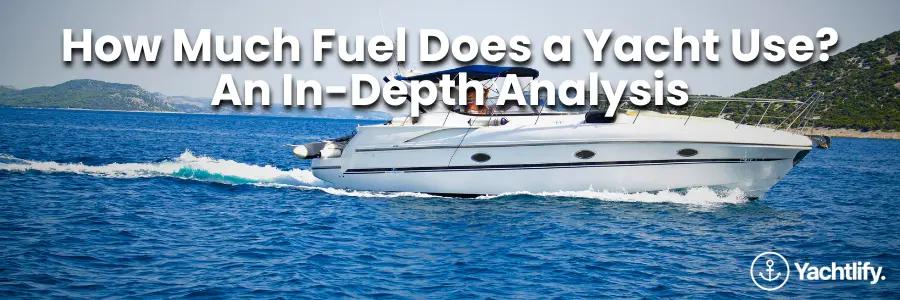
When it comes to luxury and adventure on the high seas, yachts are the epitome of both. Whether you’re a yacht owner or dreaming of chartering one for your next vacation, understanding the fuel consumption of these majestic vessels is crucial. Fuel usage not only impacts the cost of your journey but also has environmental implications. In this article, we dive into the factors affecting yacht fuel consumption and provide insights to help you estimate how much fuel a yacht uses.
Understanding Yacht Fuel Consumption
Fuel consumption in yachts is influenced by several factors, including the yacht’s size, engine type, cruising speed, and conditions at sea. Here, we break down these elements to give you a clearer picture.
Yacht Size and Engine Type
Yachts come in various sizes, from smaller 40-foot models to massive 100-foot plus luxury liners. Generally, the larger the yacht, the more fuel it consumes. Engine type also plays a significant role. Traditional diesel engines are common, but newer models may feature more efficient or hybrid engines that can impact fuel usage.
Cruising Speed
Speed is a significant factor in fuel consumption. Higher speeds increase resistance in the water, requiring more power and, consequently, more fuel. Cruising at a yacht’s optimal speed, often referred to as the “hull speed,” can help maximize fuel efficiency.
Conditions at Sea
Sea conditions can also affect fuel consumption. Smooth, calm waters allow for more efficient travel, while rough seas can increase fuel use due to the additional power needed to maintain speed and stability.
Estimating Yacht Fuel Consumption
While it’s challenging to provide a one-size-fits-all answer due to the variables involved, we can offer some general guidelines. On average, a yacht might use between 20 to 100 gallons of fuel per hour. Smaller yachts, such as those around 40 feet, tend to be on the lower end of the scale, consuming about 20 to 40 gallons per hour. Larger vessels, which are over 100 feet, can consume significantly more, sometimes exceeding 100 gallons per hour, especially at higher speeds.
Example Calculations
Let’s look at an example. For a 70-foot yacht cruising at a moderate speed of 20 knots, fuel consumption could be around 50 gallons per hour. If you’re planning a 100-mile journey, at 20 knots, it would take you approximately 5 hours. This means the total fuel consumption for the trip could be around 250 gallons.
Tips for Reducing Fuel Consumption
- Cruise at Efficient Speeds: Find and maintain your yacht’s hull speed for optimal fuel efficiency.
- Regular Maintenance: Keep the engine and hull in top condition to reduce drag and ensure the engine runs efficiently.
- Plan Your Route: Opt for the most direct route and consider current sea conditions to minimize unnecessary fuel use.
- Lighten Your Load: Only carry what you need for your journey, as extra weight can increase fuel consumption.
Understanding and managing fuel consumption is crucial for any yacht owner or enthusiast. By considering the factors outlined above and implementing fuel-saving strategies, you can enjoy the luxury of yachting more sustainably and cost-effectively. Whether planning a short excursion or a long voyage, a careful consideration of fuel use will enhance your experience on the water.
Remember, every yacht is unique, and so is its fuel consumption. For specific figures, consult your yacht’s manual or speak with a marine professional who can provide insights tailored to your vessel. Enjoy your time at sea, and sail smartly!
Listing your boat with Yachtlify provides several unique benefits, including:
- List once, post on multiple platforms (Yachtlify.com, Facebook Marketplace, Instagram, and others).
- Schedule showings and sea trials with our calendar and reminders.
- View listing engagement analytics across platforms.
- eSign, state forms, and Coast Guard forms to manage closing documentation in once place.

2005 Couach 114ft / 34.7m
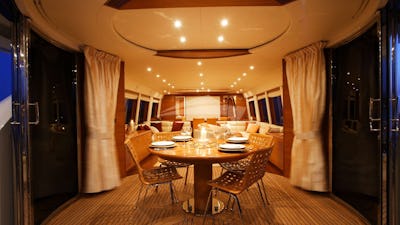
ECLIPSE Yacht Charter
ECLIPSE currently registered in Jamaica is actively available for charter.
The luxury motor yacht ECLIPSE was built by Couach and delivered to her owner in 2005, she later underwent a refit in 2020.
The exterior of ECLIPSE is designed by Couach.
Charter guest accommodation
ECLIPSE has been designed to comfortably accommodate up to 10 charter guests in 5 suites.
The guest cabins comprise 5 cabins with a queen size bed and en-suite bathroom facilities.

Your luxury charter crew
Your luxury charter on board motor yacht ECLIPSE will be managed by the crew of 5 including the captain.
The crew will ensure you have a relaxed and enjoyable charter experience with all of your needs catered for while on board.
The 5 crew have their own separate crew quarters allowing guests to enjoy increased levels of privacy.
Amenities & Entertainment
Amenities on board for the charter guests include Air Conditioning, BBQ, Outdoor shower, Indoor audio system, Jacuzzi on deck, Swim platform, TV saloon and Wi-Fi.
An extensive list of further amenities and water toys can be seen under the features and amenities section.
Yacht charter destinations
ECLIPSE is Currently cruising in the Caribbean.
Sample itineraries for the cruising destinations can be supplied by your professional charter broker allowing you to plan your luxury yacht charter vacation in detail.
- Windward Islands
- Leeward Islands
- Air Conditioning
- Outdoor shower
- Indoor audio system
- Jacuzzi on deck
- Swim platform
- Floating mats
- Jet Skis (standup)
- Paddleboards
- Tube - towable
- Water skis - adult

Jacobus (Jaco) Pieterse

Captain Jacobus Pieterse spent his childhood growing up grew up along the ocean and in the city in his native South Africa. He originally hails from Empangeni, which is a city in KwaZulu-Natal, South Africa, approximately 157 kilometers north of Durban, set in a hill countryside, overlooking a flat coastal plain and the major harbour town of Richards Bay which is 16 kilometers away, A very friendly, easy going and accessible person, everyone just calls him JACO (pronounced Yako). Besides swimming, Jaco excelled at rugby and boxing as a youth. His love of the water moved him on to a yachting career, he now has 30 years of experience on the water, from chartering, diving, and delivering yachts, both power and sail. Jaco is an easy to talk to person, who has a sense of adventure and relishes exploring new places. He spent a lot of time cruising the Indian Ocean, which he loves for its vast unspoiled areas. He arrived to Saint Maarten about 6 years ago and has been cruising the local waters there ever since. The area has become a home of sorts, and Jaco has designed interesting venues for all types of guests, depending on what they want to do, be it intensive watersports, horse back riding, touring, or just quiet pristine places to relax. He feels the service on board should tailor to the guest’s preferences. From a friendly casual atmosphere to a refined discreet silver service, Jaco will deliver what fits! His motto is “Be honest and real to yourself and others”. His straightforward enthusiasm and attention to details ensures an excellent charter on board Yacht Eclipse!
MARCO DE VILLIERS

Marco is from Welkom, South Africa. He and his 2 brothers spent time on the farm and in the city growing up. As a child Marco pursued soccer and motor cross, and enjoyed a lot of fishing. In 2018 Marco decided it was time to see more of the world, and he followed his curiosity and love of the ocean to begin sailing. He decided he really liked yachts and watersports and has been working aboard various vessels ever since. His travels introduced him to one of his favorite locations, The Bahamas. There he was able to hone his yacht and water based skills and learn more of the beautiful underwater world. Besides his love of the ocean, Marco is a musician and DJ, Besides being there to assist in watersports and adventure, he will see that the music and fun is just right for guests aboard. He is a friendly, hardworking, and helpful part of the Eclipse crew! His motto is the “Life is amazing and is what it should be!”
MERUGIA VELDKAMP

Marugia is from The Netherlands. An adventurous soul, she spent time in Australia acquiring skills that have been a great aid to her job on board Eclipse. She has been waitress, hostess, barista, and bartender and also worked as a housekeeper and a social counselor. Some of her favorite activities are water sports, singing and Salsa dancing! But, do not let that sweet demeanor fool you, as this athletic young lady is also a black belt in Tae Kwon Do! Marugia started working on Eclipse as the second stewardess, but her job performance and dedication now have her in the position of Chief Stewardess. She always looks forward to hosting and serving the guests aboard!
Destinations
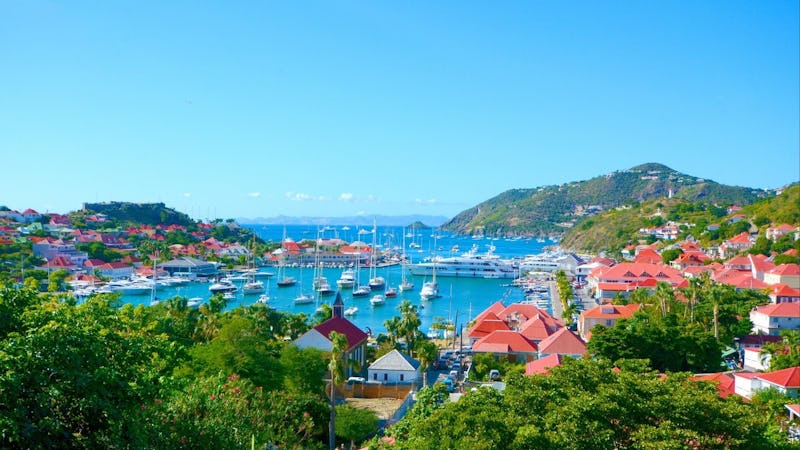
Frequently Asked Questions
How much to charter eclipse.
ECLIPSE has a weekly charter price starting at $75,000 and an estimated daily charter price of $12,500.
How many guests on board ECLIPSE?
ECLIPSE can accommodate 10 sleeping guests on board in 5 cabins, with the ability to cruise with up to 10 guests and entertain groups up to 10 guests while at anchor or moored at a marina.
Legal Disclaimer
Motor Yacht ECLIPSE is displayed on this page for informational purposes and may not necessarily be available for charter. The yacht details are displayed in good faith and whilst believed to be correct are not guaranteed, please check with your charter broker. Charter Index does not warrant or assume any legal liability or responsibility for the accuracy, completeness, or usefulness of any information or images displayed as they may not be current. All yacht details and charter pricing are subject to change without prior notice and are without warranty.
U.S. Customs & Border Protection
The yachting industry has no global listing service to which all charter yachts must subscribe to, making it impossible to ascertain a truly up-to-date view of the market. Charter Index is a news and information service and not always informed when yachts leave the charter market, or when they are recently sold and renamed, it is not always clear if they are still for charter. Whilst we endeavour to maintain accurate information, the existence of a listing on Charter Index should in no way supersede official documentation supplied by the representatives of a yacht.
Specification
| Yacht name | ECLIPSE |
|---|---|
| Speed (cruising) | 42.6kph / 23kn |
| Speed (max) | 55.6kph / 30kn |
| Fuel consumption (max) | 567.8lph / 150gph |
| Range (max) | 1852km / 1000nm |
| Engine | 2 x MTU V 16 motors of 2400 CV each 2 x Kohler 55 generators |
| Hull | Monohull |
| Flag | Jamaica |
| Launched | 2005 |
| Refitted | 2020 |
| Builder | Couach |
| Designer | Couach |
Popular related yachts


- Charter & Brokerage
- Yacht Design & New Builds
- Tenders & Toys
- Superyacht Events Calendar
- Career & Training
- Departments
- Superyacht Crew Finances
- Sustainability
- Shipyards and Marinas
- Health & Wellbeing
- Polar Region
- Our Services
- Meet the Team
Yachts And Fuel – How Much Do They Really Consume?
.png)
Fuel is one of many annual running costs of a yacht. Not only does the yacht need fuel for cruising; the generators require it to keep the vessel running while at anchor and underway. As well as this, many of the water sports toys require it too.
Some yachts cross the Atlantic Ocean twice a year between the Mediterranean and Caribbean while others embark on world cruises. That equates to a lot of fuel.
So How Much Do They Really Consume?
According to the Yachting Pages, the longest Superyacht in the world, 180m M/Y Azzam, holds 1,000,000 litres of fuel. To put it into perspective, that is the equivalent of filling a regular hatchback car 23,800 times. Or, six Boeing 747 commercial airliners.
West Nautical’s Vessel Manager, Tony Hildrew, a former Yacht Chief Engineer said:
“Fuel is the single biggest expense when it comes to yacht operations, it is estimated that the global spend on fuel is around $150bn annually however this shouldn’t put you off, there are a number of ways to ensure your fuel consumption doesn’t get out of hand. Implementing a Ships Energy Efficiency Management Plan or SEEMP for short is a great way to keep fuel costs down without compromising on your cruising experience.”
Each yacht will consume fuel differently for a number of reasons. It could be the size and make of the engines. Or, how often the yacht is using generators. As well as the number of tenders and water sports toys on board that require fuel. For example, if the yacht is out at anchor and running on generators 90% of the time, the fuel consumption will be much higher than a yacht that is in a marina at night and connected to shore power and water.
Another factor that will affect fuel consumption is the yacht’s itinerary. This is because the sea conditions will impact how much fuel the engines consume.
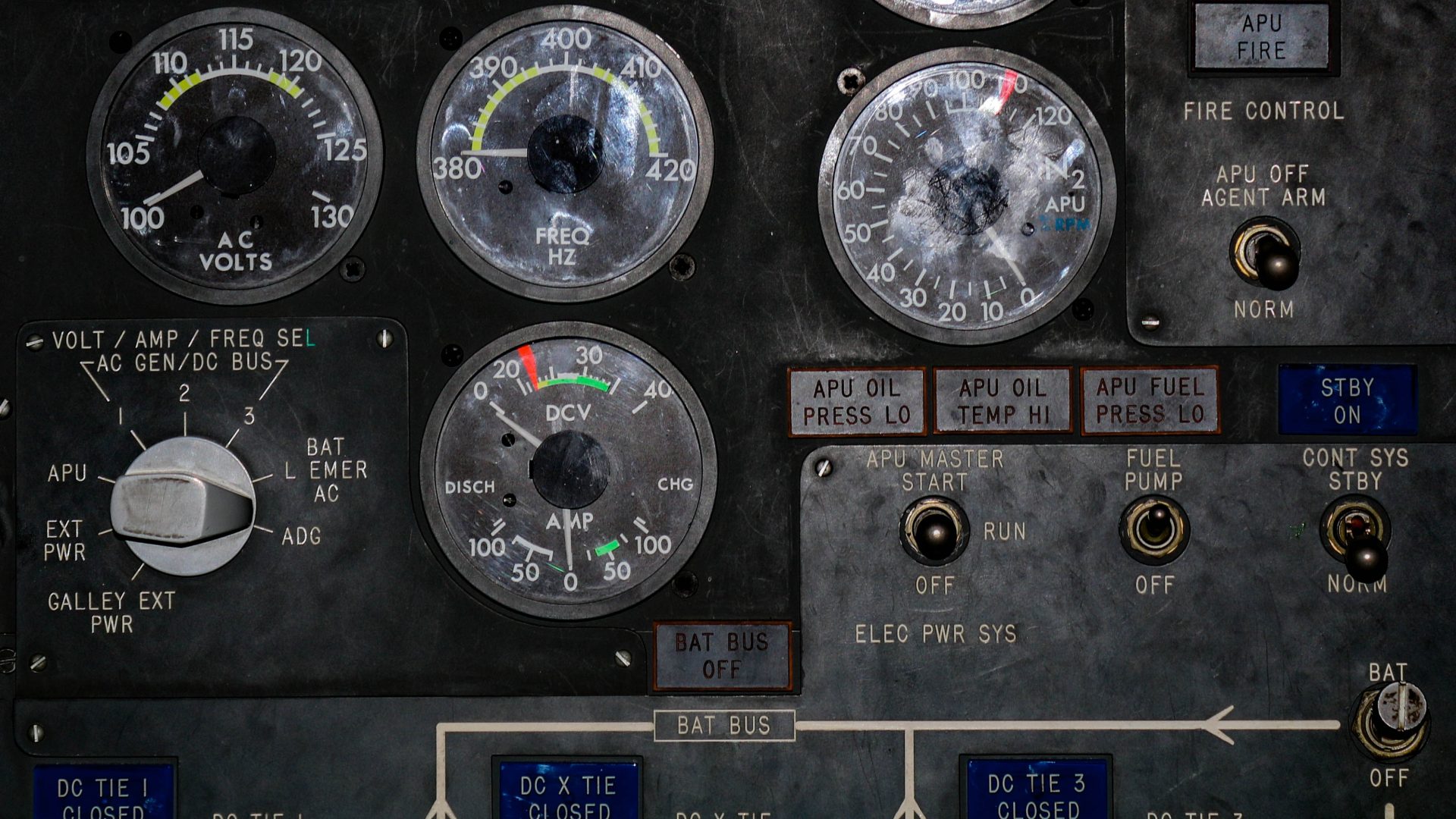
How Is Consumption Measured?
You will be able to input the start and ending points of your cruise on the map. This will automatically update the distance table. The next step is to enter the speed, fuel consumption and cost of fuel per litre to determine the cost of the trip.
Here is an example: A fast 30m yacht cruising at 20 knots will consume roughly 400 – 500 litres depending on the engine type. This would equate to the total consumption of 2500 litres for a distance of 100 nautical miles.
Another example is, a 70m yacht looking to travel 100 nautical miles with the engines burning 1000 litres per hour would add up to a total consumption of 8335L for that passage. Depending on where the yacht bunkered, the estimated cost with the price per litre being on the low end at €0.90 per litre would cost a total of €7501.50. An example of a 100 nautical mile passage would take you from Saint Tropez to The North Coast of Corsica.
How Much Does It Cost?
Fuel prices fluctuate depending on which country you bunker in and some places you bunker offer tax free fuel such a Gibraltar and Montenegro. Fuel prices can vary but typically costs between €0.80 and €1.30 per litre.
Yacht charter, sales and management company West Nautical added:
“Fuel costs should be at the top of any yacht owner and captain’s minds for two reasons: to minimise costs as well as reduce the environmental impact of burning unnecessary fuel. The superyacht charter market, more than most other markets, relies on pristine waters for their guests to enjoy their holiday. If the oceans in popular charter destinations are not maintained, it will decrease the demand for yacht charter and therefore the revenue for owners.” “If you are looking for expertise in operational management and engineering in order to plan a SEEMP, West Nautical would be delighted to assist.”
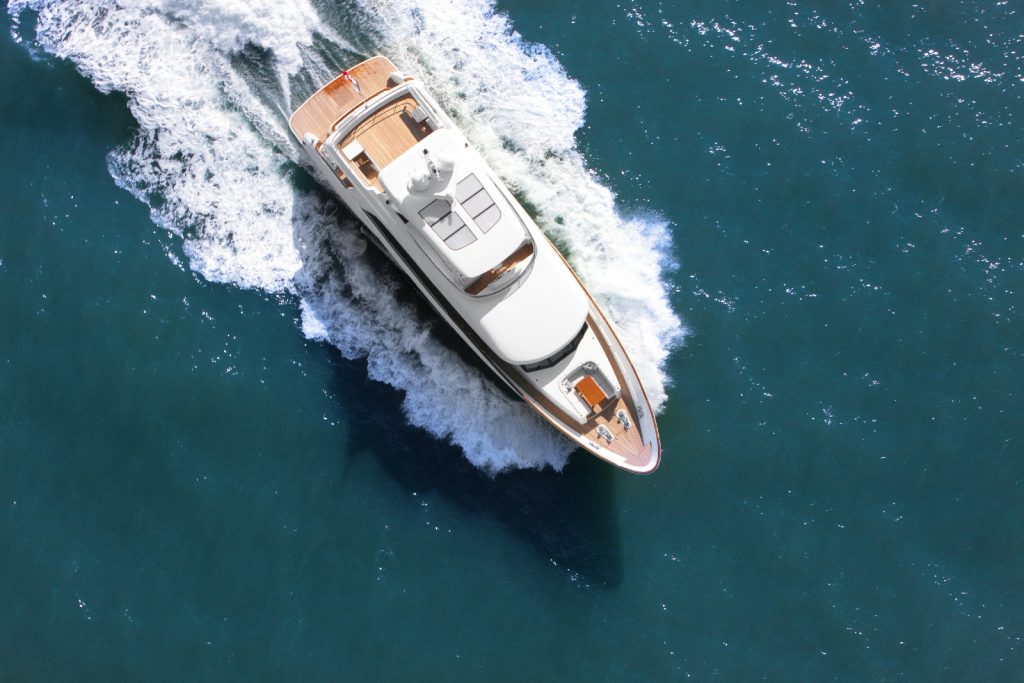
About West Nautical
West Nautical sell, charter and manage superyachts from their head office in Newcastle upon Tyne. The business currently employs a team of 21 staff throughout their offices based in the UK, Russia, France and Cyprus.
Since their inception over 25 years ago, West Nautical have become recognised as one of the most respected, trusted, knowledgeable and accountable professional services firms in yachting – largely due to their relentless determination to act in our clients’ best interests. Their approach and attitude is transparent, refreshing and focused on providing value-added services delivered simply, elegantly and affordably.
Visit West Nautical’s website here: https://westnautical.com
For Media enquiries please contact sarah.mackenzie@westnautical.com
To keep up to date with the latest Superyacht Content News, click here .
Sign up to our Newsletter below:
Newsletter Signup
- Your Name First Last
- Your Email *

West Nautical
Related articles, a scotland trip for superyacht tenders. trying out the nautique range, tender of the week: maori 54, tender of the week: maori 46, q&a with sober crew social club. where sober doesn’t have to mean boring.

Superyacht Content
Social media influencer and digital brand expert.
Superyacht Content brings you the latest in social news for the superyacht industry.
Keep up to date with us across our social channels, and don’t forget to hit that share button!
- Superyacht News
- Superyacht Jobs
- Superyacht Marketing
Join our Newsletter
Copyright © 2023 Superyacht Content | Website Design by Zonkey
Privacy | Credits | Get in Touch

Do you operate a yacht? Our app is perfect for you
Yacht fuel cost calculator - how to estimate the costs.
Yacht captains have many responsibilities when it comes to the management of their vessel. One of them is keeping track of expenses, which is why it is important to familiarize yourself with the vessel’s operational costs. Keeping a luxury superyacht afloat isn’t cheap, and many claim that the average annual cost ranks up to 10% of the vessel’s price.
From these expenses, a significant portion goes to fuel. Filling up the tank of your boat is quite pricey, which is why a growing number of boat owners want to know exactly how much they are looking to spend for their upcoming voyage. This is also important for people who want to charter a boat for their holiday.
If you’re wondering how to best estimate the costs involved, you’re in the right place. This article will help you calculate your vessel’s yacht fuel cost while giving an overview of all the criteria used as variables. To make the process even easier, we link to a yacht fuel cost calculator to help you get an indication of the expenses you’ll need to cover. Let’s delve in!
Yacht fuel cost calculator
How to estimate yacht fuel costs, how much fuel does a yacht use.
- Price of boat fuel per gallon?
Yacht fuel formula
The easiest way to calculate your fuel costs is by using a yacht fuel cost calculator. There is a great calculator available here in case you want to save time and get an approximate estimation.

As you can see, the yacht fuel cost calculator has many variables which you need to be aware of before you set out to calculate the approximate price. This is what we will be dealing with in the next few chapters.
To help you get a better understanding of the calculation process we will do things manually while giving you the exact formulas used to calculate your vessel’s fuel needs. Therefore, make sure you keep on reading.
There are several things you need to keep in mind when you first set out to estimate the total fuel cost for your next voyage. These are summarised in the following points:
- Distance of journey - The total amount of nautical miles (or km)
- Cruising speed - The (average) speed of your vessel (in knots or km/hr)
- Fuel consumption - Understanding how many gallons (or liters) of fuel are consumed per hour
- Yacht fuel price - Understanding the average market price per gallon of fuel
The first two points depend solely on your needs and personal preference, which means that they are more flexible on a subjective basis. The latter two points may require a bit of research, especially if you’re not familiar with the engine of the vessel.
In the following sections, we will delve deeper into each of the points mentioned above, and offer the required formulas to help you calculate yacht fuel cost.
Calculating distance and speed
To understand the exact distance you are looking to cover in your next voyage, you can simply use Google Maps to plan your route. The following video explains the process in detail.
As soon as your route is planned out, you can measure the distance as well, selecting the preferred method of calculation. In our case, it is best to measure in nautical miles (1nm=1,85km), as this metric is more commonly used among sea men. The yacht fuel cost calculator above has an embedded map that helps you pinpoint the journey you want to make.
Next comes the cruising speed. The number is mostly calculated in knots (nautical miles/hr). The speed with which the vessel will cruise depends on the captain onboard, but is often influenced by the owner and guests onboard. You can make a rough estimation of this number based on previous trips.
Next, we need to calculate the amount of fuel that you will likely need. To do this we need to understand the engine type, its horsepower, and several other factors.
Let’s take a marine diesel engine for example. These engines are very common on motor yachts and consume approximately 0.4 pounds of fuel per hour for each unit of horsepower. You can find fuel consumption info for your specific engine by looking it up on the web or by calling the service number.
Once you know the fuel burn rate, it’s best to add a relative error margin of 10% based on minor factors. These include weather conditions, vessel size, and drag, all of which can increase the fuel burn.
How much fuel does a yacht use per hour?
Now that you know all the variables you can go ahead and calculate the amount of fuel that your yacht will need.
- Start by calculating the fuel burn per hour based on the horsepower of the engine.
- Add a multiplier based on the cruising speed of your vessel.
A vessel with a diesel engine of 300 horsepower will most likely burn 16-17 gallons per hour, which you can then use as a guideline when calculating the travel time based on the nautical miles you are looking to cover.
Superyachts are consuming much more fuel. An average 70-meter luxury yacht will burn around 130 gallons per hour with the engines running, while the amount increases significantly when the ship is moving. On average, you are looking at ±€2000 per hour (±1000 gallons) to achieve a speed of 20 knots. Of course, the higher the cruising speed, the more fuel you will be burning per hour, which in turn makes each hour at sea more expensive.
How much does boat fuel cost per gallon?

The exact price you are looking to pay per gallon depends on the marina you find yourself in. By looking at several price points of marinas, we get the following:
- Average diesel prices range from $3.2-$3.9 per gallon
- Average petrol prices range from $7.2-$7.8 per gallon
Note that discounts usually apply whenever you choose to purchase large quantities of fuel.
Why is boat fuel so expensive?
Marine fuel pricing is heavily inflated due to low supply and high demand. In short, the limited number of fuel stations at marinas have to service all the yachts that dock, which leads to a no-choice monopoly.
That said, yacht owners are usually not that concerned about the small price spike that marinas charge as an extra. If anything, they are happy to pay due to the convenience of the service.
How much fuel does a yacht hold?
Once again, the answer to this question depends on the size of the vessel. Smaller yachts can hold around 1300 gallons of fuel, while the bigger vessels can store up to 100,000 gallons. The ship’s engineers should be able to provide this number for the vessel you command.
Now that we have a better understanding of all the variables that determine the cost of fuel, we can go ahead and take you through the calculation process step by step.
First, know the total duration of your cruise. To obtain this information, divide the number of nautical miles by the cruising speed of your vessel (knots). For example, if you want to make a journey that totals 150 nautical miles while traveling at 20 knots, the yacht fuel formula looks as follows:
Total duration = 150 nm / 20kn
Total duration = 7,5 hrs
Note that the amount of fuel consumption may end up higher than expected if:
- Sea and weather conditions are not favourable
- You plan to make short stops along the way while the engine keeps running
Next, what you want to do multiply the number of hours by the number of gallons that your engine burns on an hourly basis while moving at the speed you previously indicated. If we take, as an example, the superyacht mentioned in the previous examples, we would make the calculation as follows:
7,5 hrs x 1000 gph = 7500 gallons
Now assume that you will also make two stops along the way, an hour and a half each, in order to let the guests enjoy their time; maybe ride a jet ski.
You then multiply the added number of hours with the consumption rate of a running engine. In this case:
3 hrs x 130 gph = 390 gallons
All that is left to do now is add up the total amount of fuel needed and multiply the number with the price per gallon.
(7500+390) x $3,5 = $27615
In this example, the final cost of your will set you back a little bit more than 27 thousand dollars. Just to be safe, calculate the additional 10% (margin of error) to be prepared against unexpected mistakes. This added amount is not necessarily an ad-on when you consider chartering. Private yacht owners, however, should add the amount to their final cost.
And that's it! You should now have a better idea on the steps you need to follow to calculate the fuel costs for your yacht. While there is quite a bit of information you should keep in mind, it is best to plan out everything with detail to avoid unforeseen costs. If you enjoyed this article, check out our blog post on yacht electrical systems as well.

- Buying a Yacht
- About Yacht Charter
- Event Charters
- Destinations
- Charter Catalogues
- Yacht Management
- Charter Management
- Sale Management
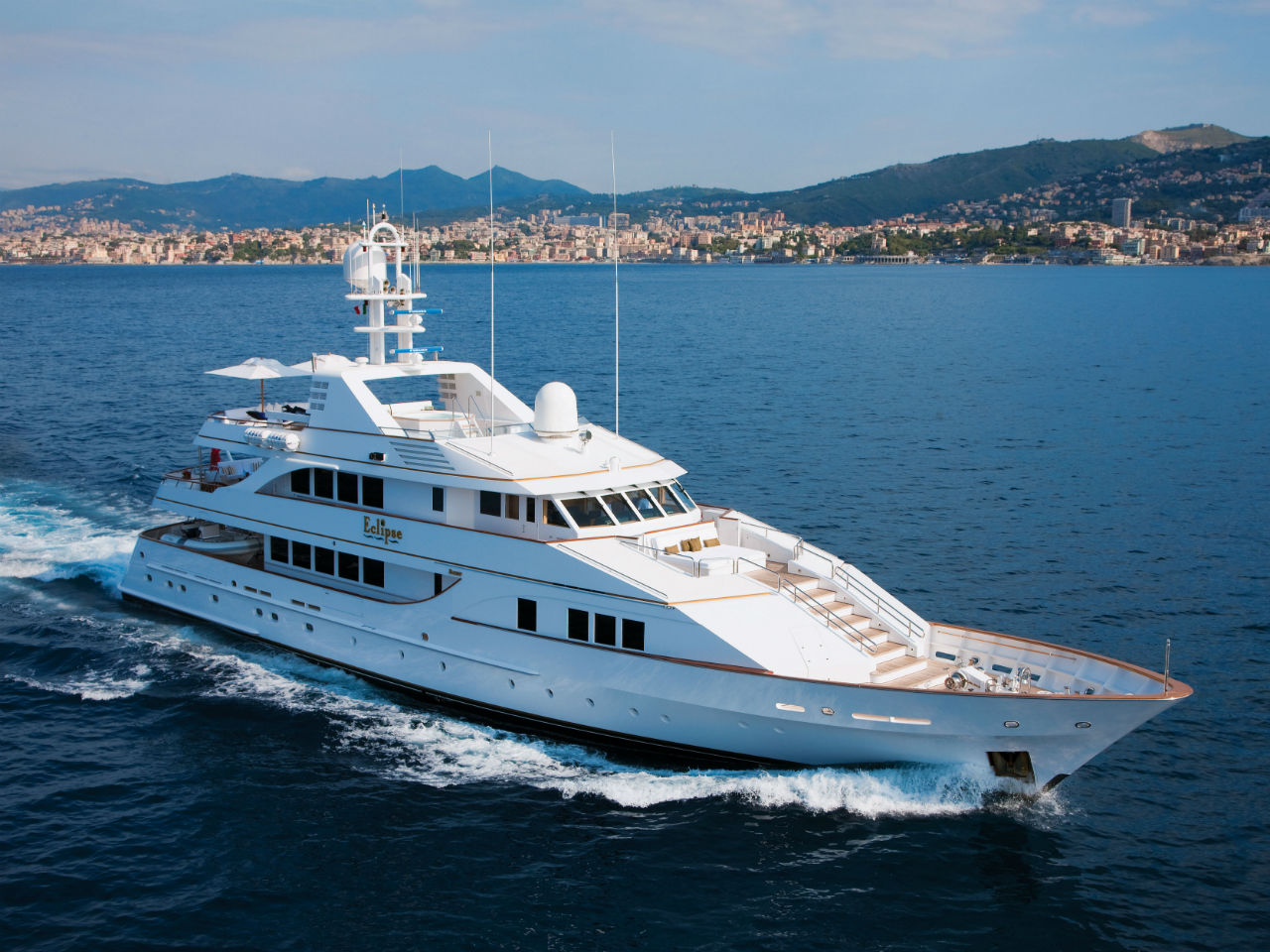
Length: 43.00m - 6 cabins
- Shipyard: Feadship Holland. U.a.
- Built year: 1993
- Refit year: 2018
- 6 550 000 €
Description
Eclipse: a worldwide known yacht This yacht is very well known in the entire world for her charter activity and her clean deisng realised by the English designer Terence Disdale. Perfectly maintained by her owners and her first class professional crew, Eclipse is a yacht that will give you an entire satifsation. As a dignified representation of the Feadship shipyard, she will allow you to sail across the ocean and in high seas with ease and speed. Discover right now what this exceptional mega yacht is able to offer. An immaculate decoration tastefully refitted. How to not succumb to Eclipse’s charm, a yacht tastefully decorated and refitted? Inaugurated in 1993 and refitted in 2018, this superyacht of 43 meters stands out not only by her striking and clean lines but also by her furniture and immaculate decoration. In addition, she offers spaces with impressive dimensions and unexpected for a vessel of this size. Modern equipment and all comfort. Eclipse is a yacht particularly well thought with her decks distributed over three levels. You will appreciate especially her big sea terrace equipped with an impressive Jacuzzi. The aft deck half-covered, next to the sky lounge, is ideal for a meal outside. Similarly, you will enjoy her entertainment equipment at the forefront of technology available in the living rooms and guests’ rooms. This yacht for sale possesses five private cabins with generous proportions, welcoming up to 10 guests on board, and a cabin with pullman, which can welcome 2 more guests. Please note that the swimming platform at the rear was conceived to offer an easy access to the sea as well as the water toys. Finally, a stabilisation system reduces the side rolls of the yacht Eclipse, giving you an incredible level of comfort at anchor or in navigation. It is without a doubt that she is, at the moment, one of the most beautiful yachts of her category available for sale. Eclipse associates prestige, comfort and all of the commodities of a classic yacht with the charm of a modern yacht, notably thanks to her two annexes (type of amenities that you find generally only on vessels of a bigger size). Communication: - Satcom and cell phone/fax - Wi-Fi is available in all the yacht (1024kB) - Possibility to make Skype video calls and FaceTime directly from the deck. - Guest laptop with printable options Gym Equipment: - Elliptical bicycle on the solarium - Yoga mat - 5kg weights - Equilibrium plank High-end performances: Eclipse is a yacht made of a steel hull and a aluminium superstructure: those characteristics allow wide spaces but also a more stable anchoring. Propelled by two caterpillar engines, she sails comfortably at 12 knots and can reach a maximum speed of 13 knots. She has as well a range to up to 4,376 miles thanks to her fuel tanks of 56,800 liters.
Specifications
- Renovation year: 2018
- Length: 43.00m (141.04ft)
- Beam: 8.40m (27.55ft)
- Draft: 3.10m (10.17ft)
- Caterpillar 3508
- Cruising Speed: 12 knots
- Maximum Speed: 14 knots
Accommodation
- Number of Guests: 12
- Number of cabins: 6
- Double cabins: 3
- Twin bed cabins: 2
- Stabilisers underway: yes
- Stabilisers at anchor: yes
- Jacuzzi: yes
- Gym/sport equipment: yes
- Number of crew: 10
- Fuel consumption: 330 l/h
- Building materials: Steel
- Yacht location: Malta
Are you interested in this Yacht? Our team is at your disposal to answer all your questions!
You may also be interested in
Your source for the latest news on yachts, boats and more. Read through our articles to find out how to compare boats and find the right fit for you!
Measuring your Yacht Fuel Consumption per Hour
Oct 10, 2019
less than a min
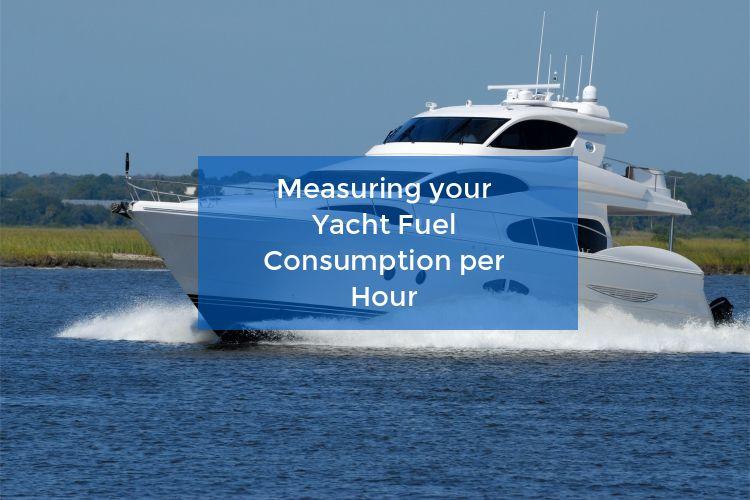
How to measure your yacht fuel consumption per hour
Yachts are quite similar to other vehicles in the sense that they work through fuel. Similarly to any other vehicle, it is important to calculate the yacht fuel consumption per hour before you plan a trip or before you purchase a vessel. Fuel consumption is also a good comparison base between boats. Whether before going on a trip, or buying a yacht, you need to have all the facts straight and know how much money you are going to invest not only at once upon purchase but also periodically.
There are different factors in the fuel consumption of a yacht. For example, if you use a generator or if you stay at anchor instead of docking, the fuel consumption will be increased . The itinerary will change fuel consumption as well. Sea is different than roads and the conditions in a sea change more dramatically than on land, which also impacts fuel consumption.
Fuel consumption for boats is measured in gallons per hour . The efficiency of boat fuel is measured in pounds of fuel that are used in an hour per horsepower. In order to be able to read the calculation right, any boat owner should know that gasoline is almost 6.1 pounds per gallon while diesel is 7.2 pounds per gallon .
Usually, if you consider that all sea conditions are pristine, the fuel consumption of a normal diesel engine is 0.4 pounds per hour for each unit of horsepower.
How to calculate yacht fuel consumption
Calculating it by hand is complicated, which is why many people choose to use online calculators . The way it works is it allows you to put down certain parameters that calculate the fuel consumption. These parameters include route , units of measurement and engine power .
Lastly , what most people are interested in is actually the cost of fuel consumption per hour. So the last parameter to include is the current price of fuel . Marine websites usually include this price up to date.
Another step that people have taken is develop a boat fuel consumption chart for their own boat and find the average in a month.
Alternatively, there is a formula that calculates the maximum fuel consumption of the engine which is:
GPH = (specific fuel consumption x HP) / The specific weight of fuel
This formula determines the fuel consumption when the engine is at full speed . If the speed is decreased then the fuel consumption is decreased as well. Basically, what you need to do is include the horsepower rate of the boat and you multiply it by the specific fuel consumption average and you divide that product by the weight of the fuel.
If you want to compare your boats GPH with other boats than you can use TheBoatDB database. If you already have a boat you can register for free and compare it with other boats within the database.
These are simple methods to calculate fuel consumption, however for a precise one you would have to know all the specifics of your boat and put the parameters through the calculator.
You might like these too

What is a Chine on a Boat lg ...
Oct 01, 2021
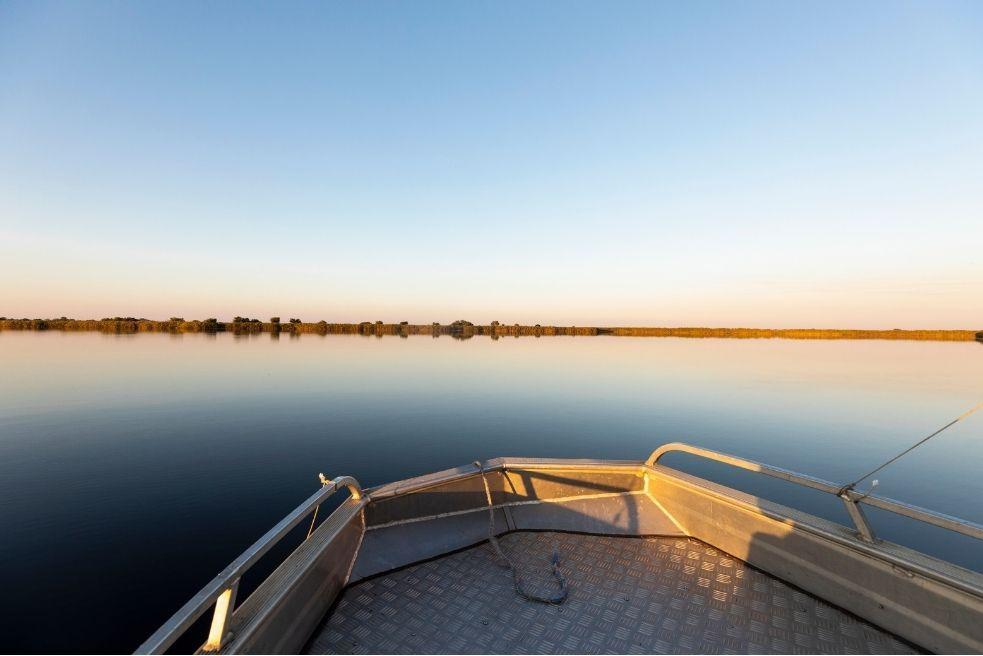
Flat Bottom Boat Advantages lg ...
Sep 30, 2021

Shoal Keel Sailboats Advantages and Disadvantages lg ...
Sep 13, 2021
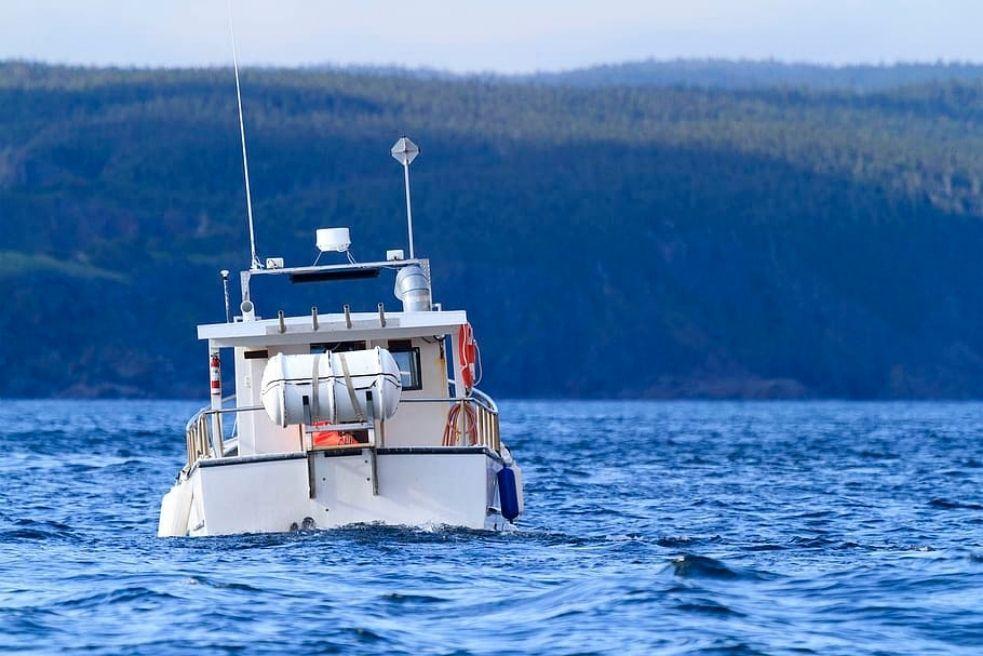
Shallow Draft Boats Explained lg ...
Sep 06, 2021
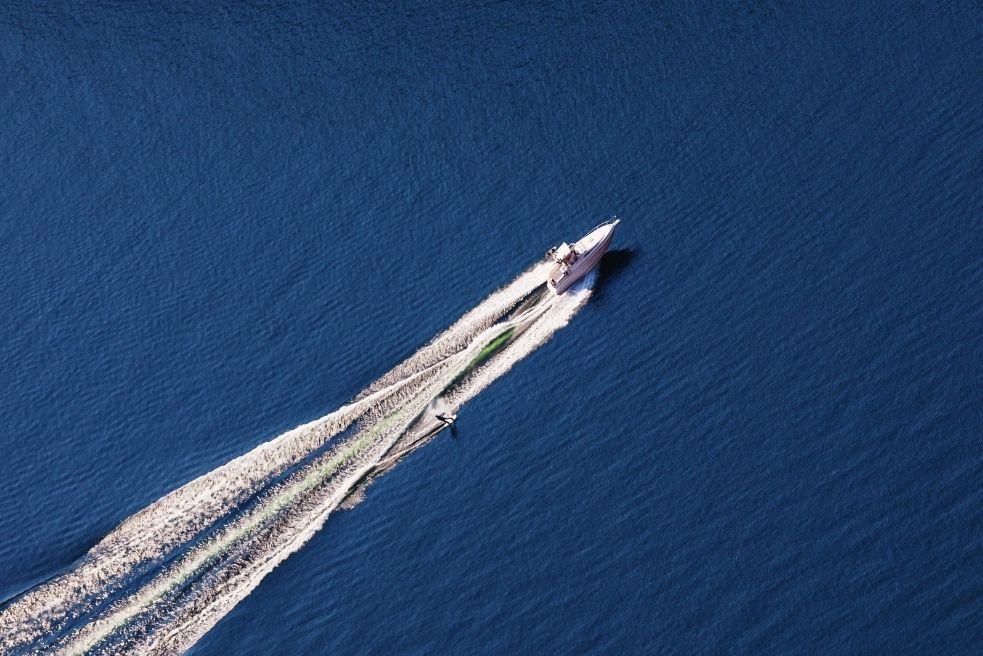
Best Boat for Open Ocean Sailing lg ...
Aug 27, 2021
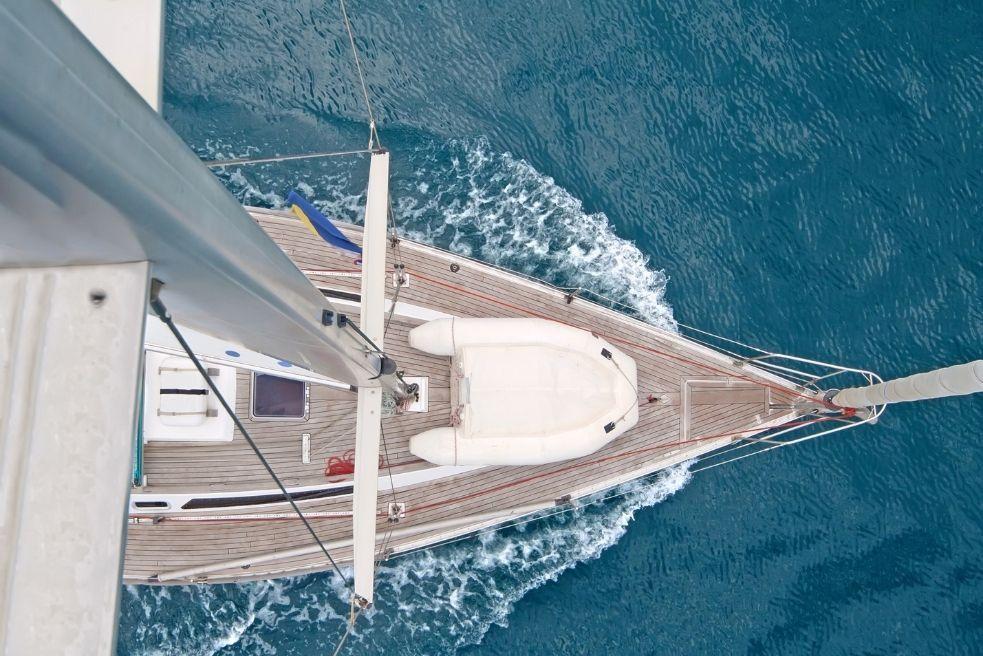
Best Boat Design for Rough Water lg ...
Aug 25, 2021
Visit our Popular Forums
- Monohull Sailboats
- Multihull Sailboats
- Powered Boats
- General Sailing
- Antares Yachts
- Fountaine Pajot
- Lagoon Catamarans
Cruising Business
- Boat Classifieds
- General Classifieds
- Crew Positions
- Commercial Posts
- Vendor Spotlight
Life Aboard a Boat
- Provisioning: Food & Drink
- Families, Kids, & Pets Afloat
- Recreation, Entertainment, & Fun
- Boat Ownership & Making a Living
- Liveaboard's Forum
Seamanship, Navigation & Boat Handling
- Seamanship & Boat Handling
- Training, Licensing, & Certification
- Health, Safety, & Related Gear
- Rules of the Road, Regulations, & Red Tape
Engineering & Systems
- Const. / Maint. / Refit
- Product / Service Reviews
- Electronics: Comms / AV
- Electrical: Batts / Gen / Solar
- Lithium Power Systems
- Engines & Propulsion
- Propellers & Drive Systems
- Plumbing / Fixtures
- Deck Hdw: Rigging / Sails
- Aux. Equipment & Dinghy
- Anchoring & Mooring
Photo Categories
- Member Galleries
- Life Onboard
- Sailing in the Wind
- Power Boats
- Cruising Destinations
- Maint. & Boat Building
- Marine Life
- Scuba Diving & Divers
- General Photos
Recent Photos

Listing Categories
- African Cats
- view more »
- Crew Wanted
- Crew Available
- Enhance Your Account
- Meet the Mods
- Meet the Advisors
- Signup for The Daily Cruiser Email

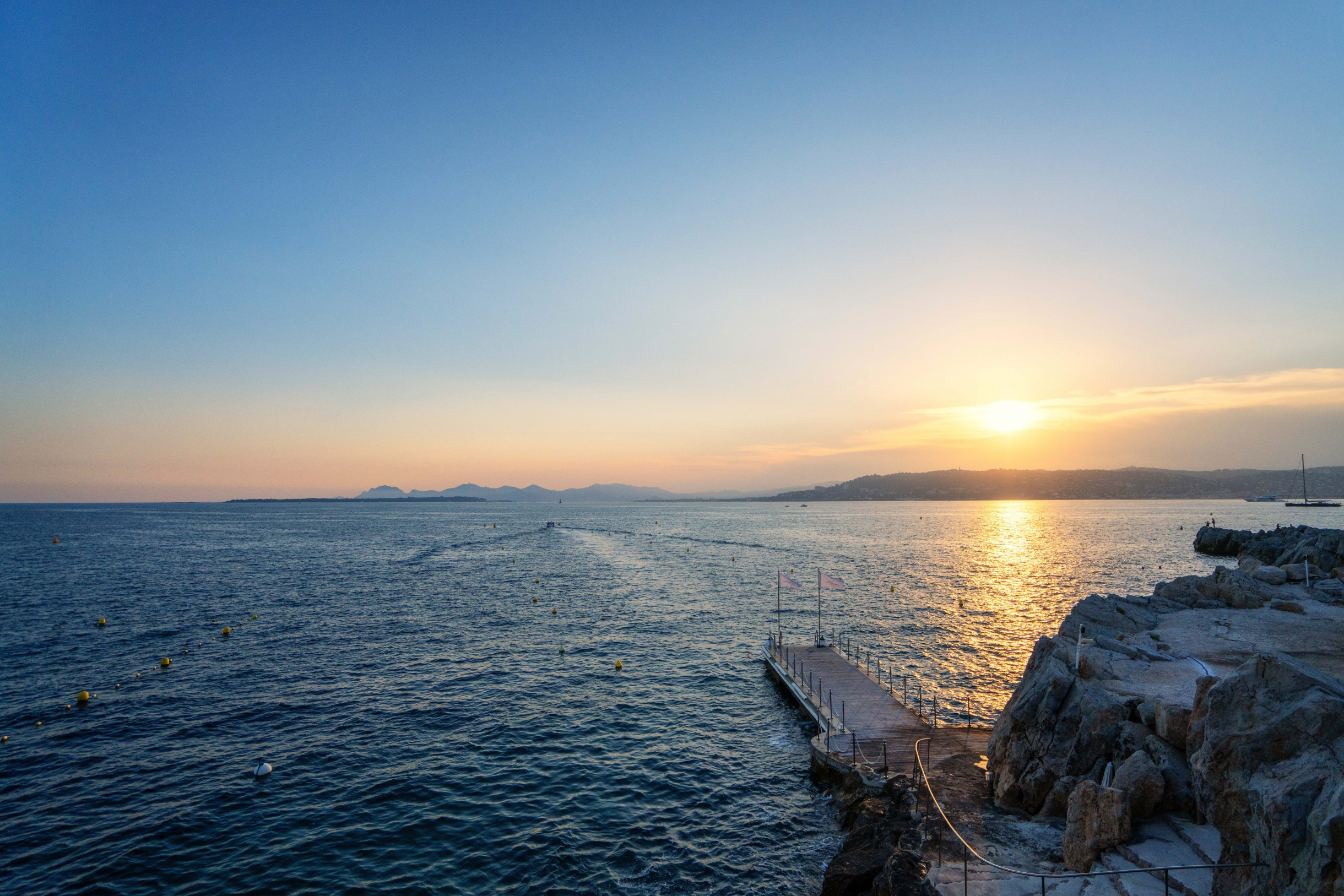
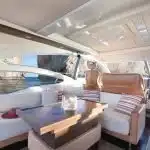
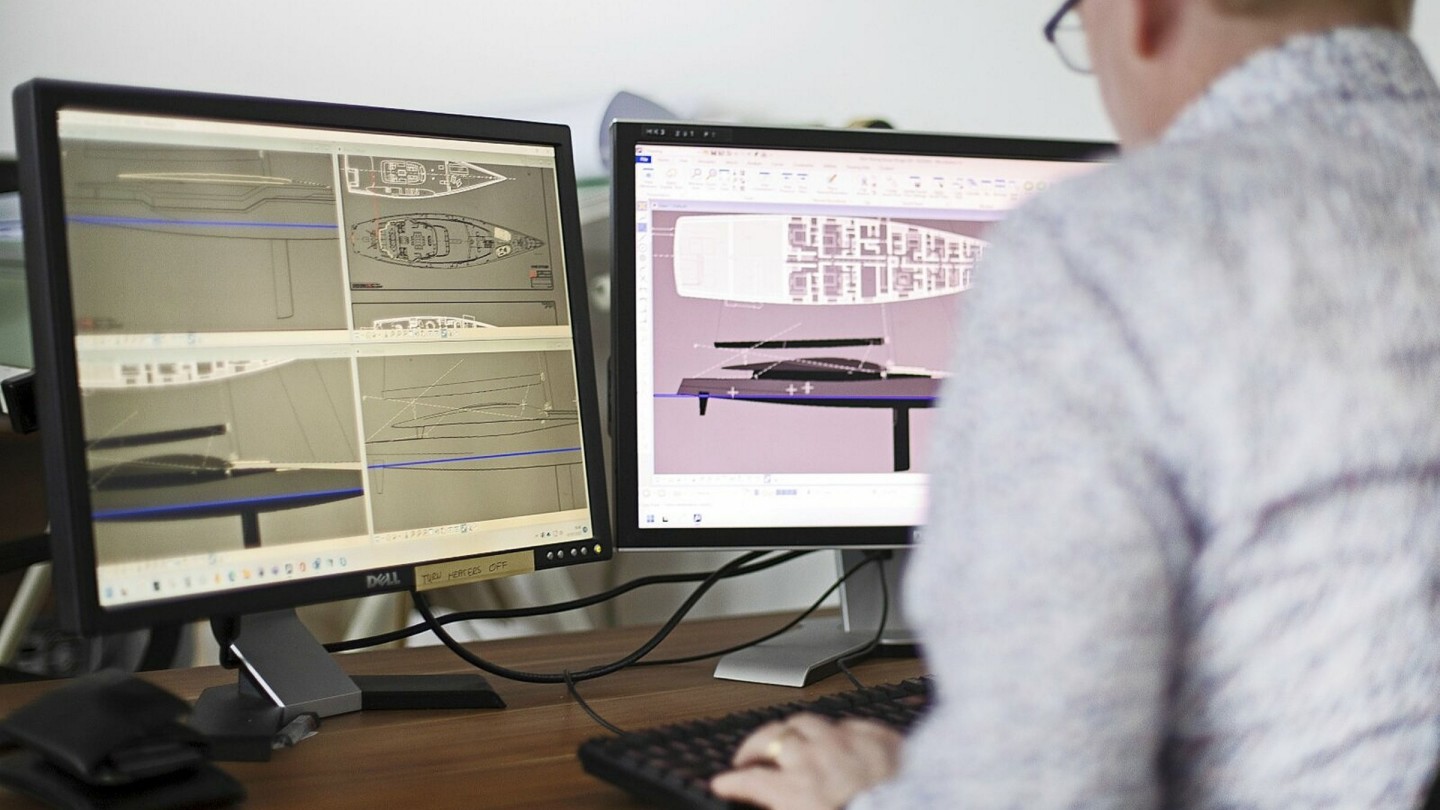







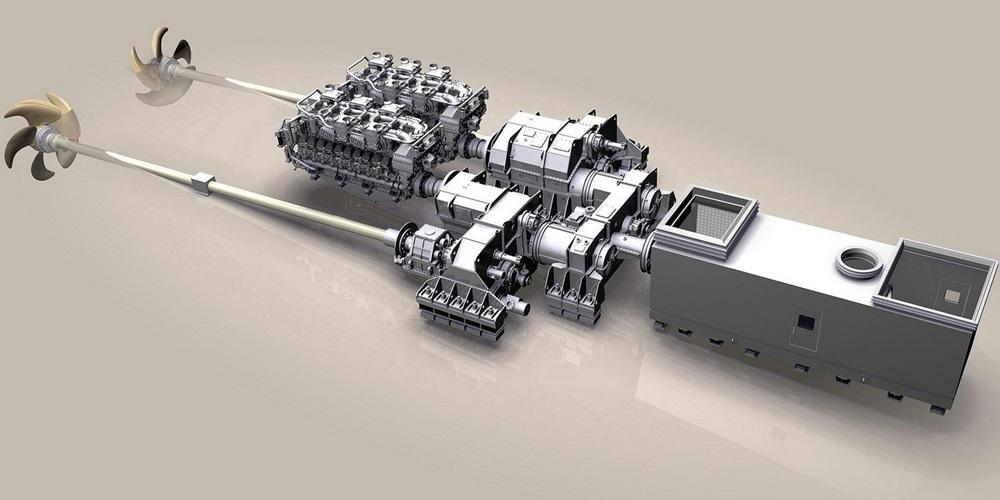
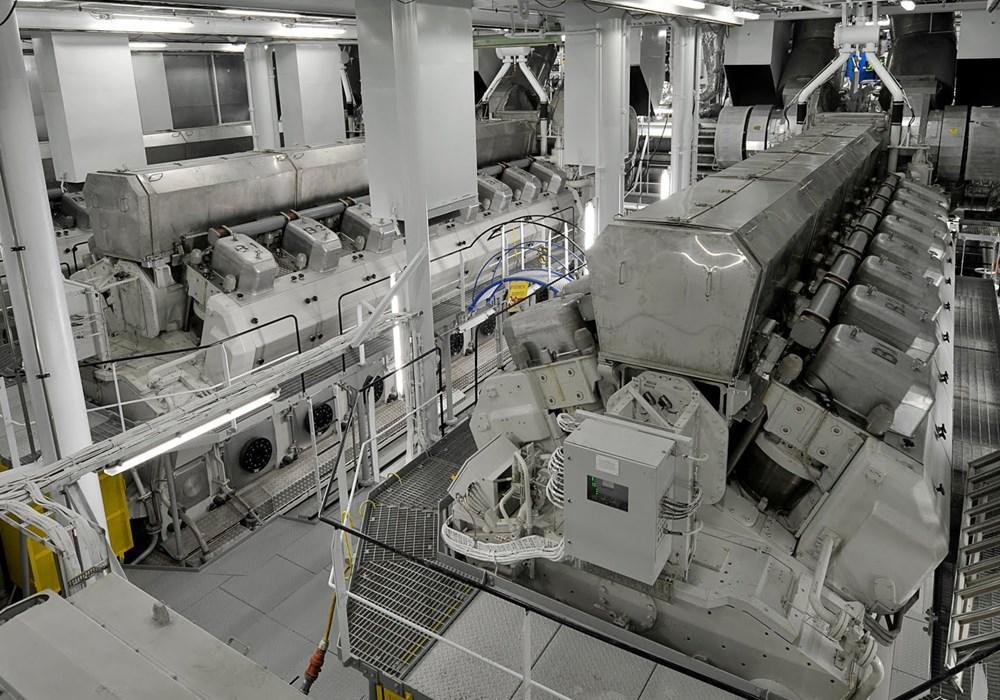
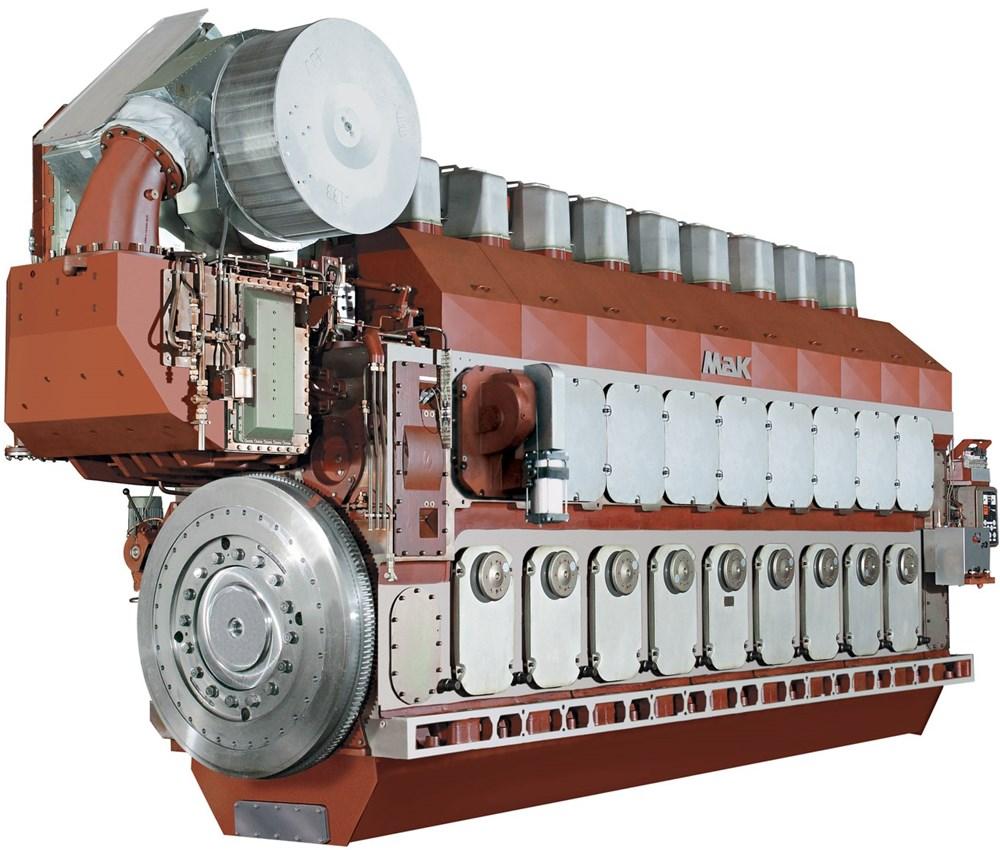
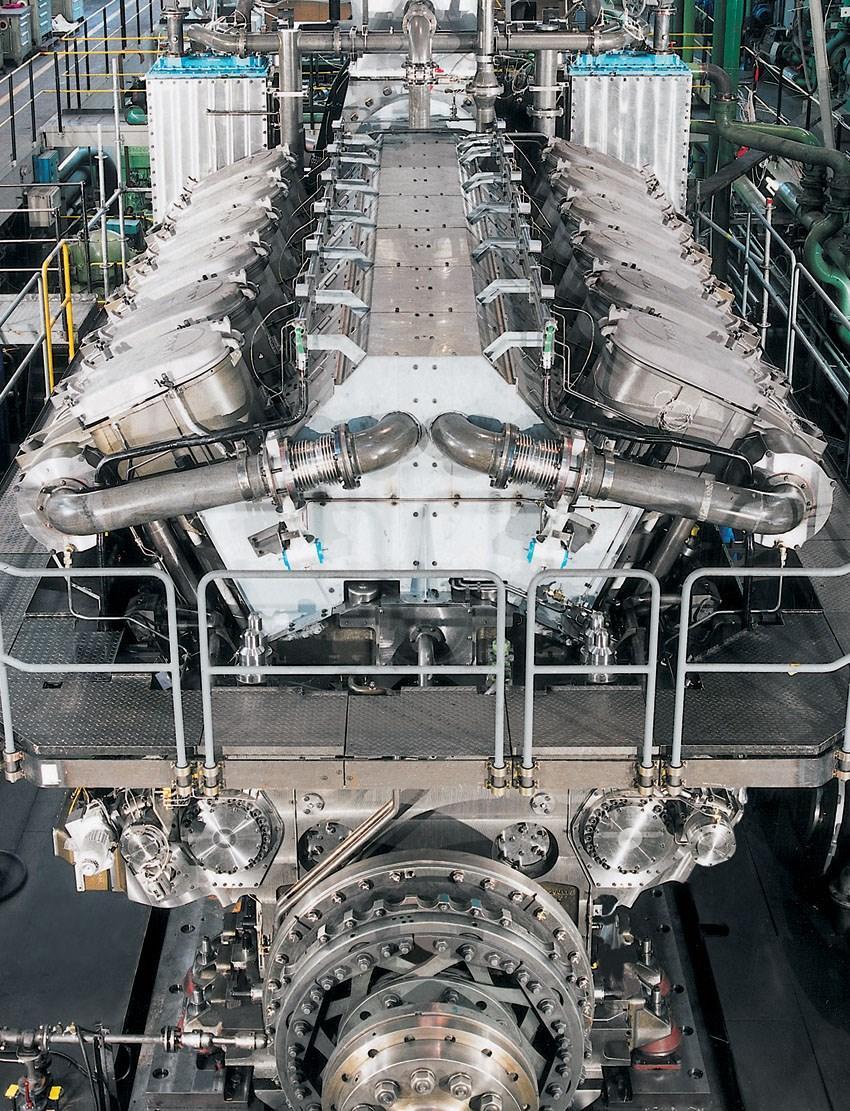
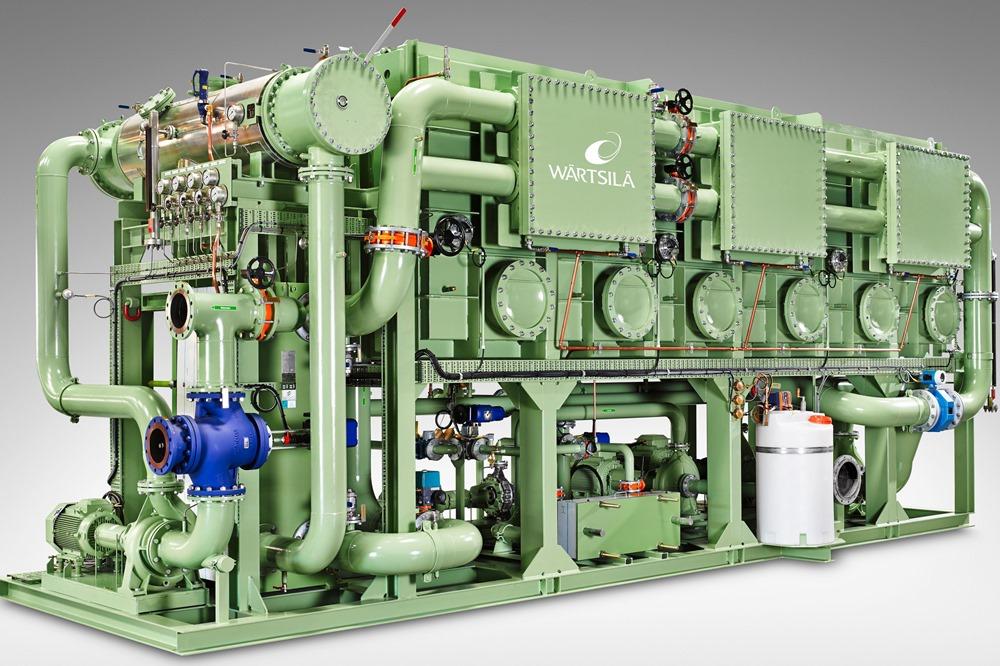
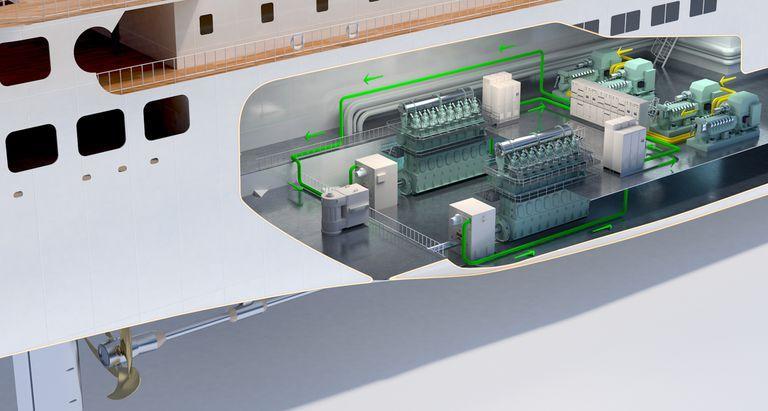
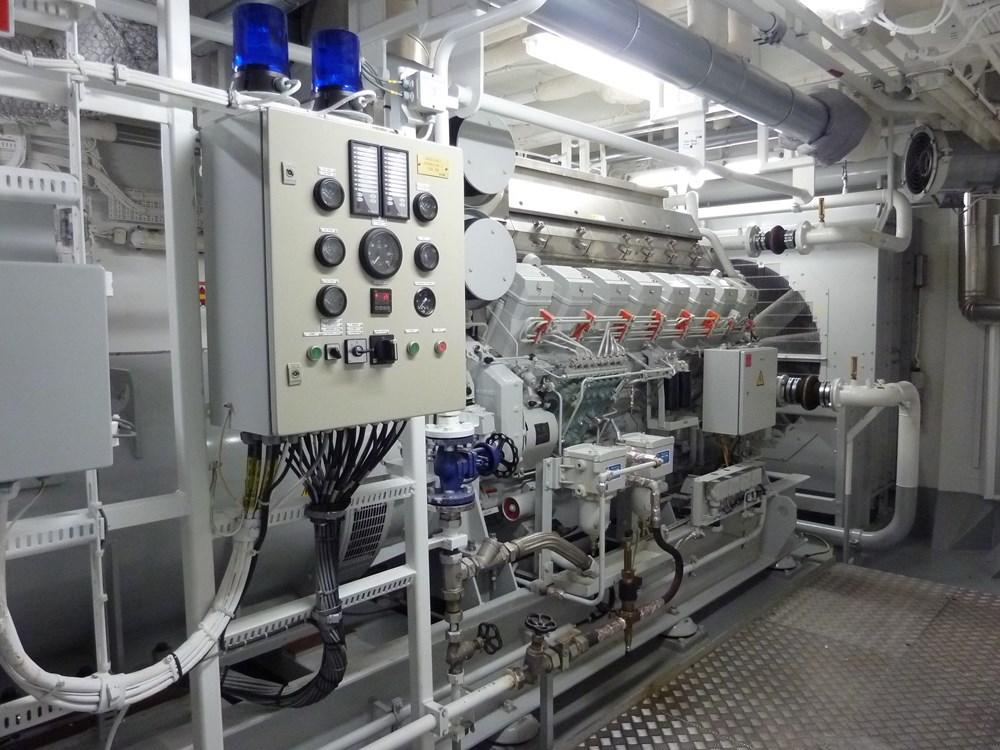
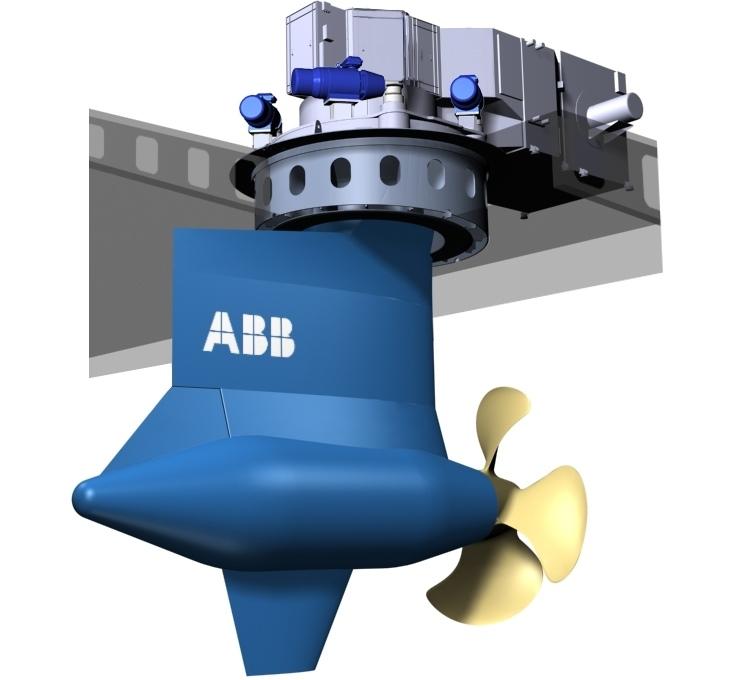
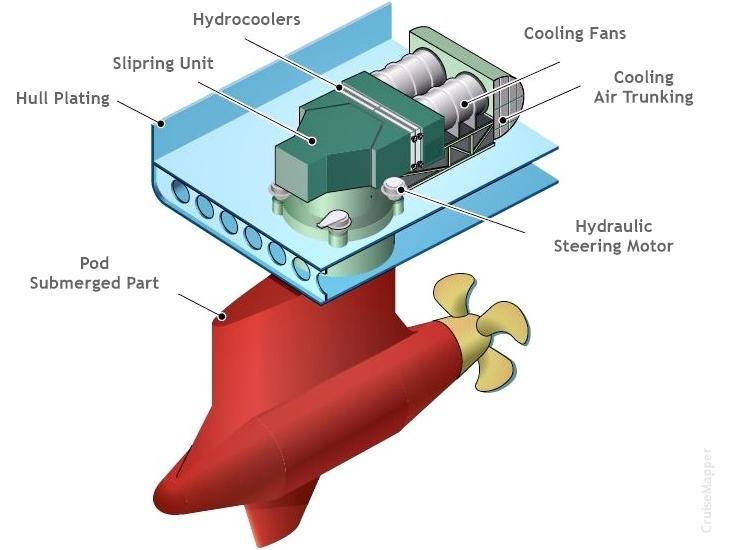
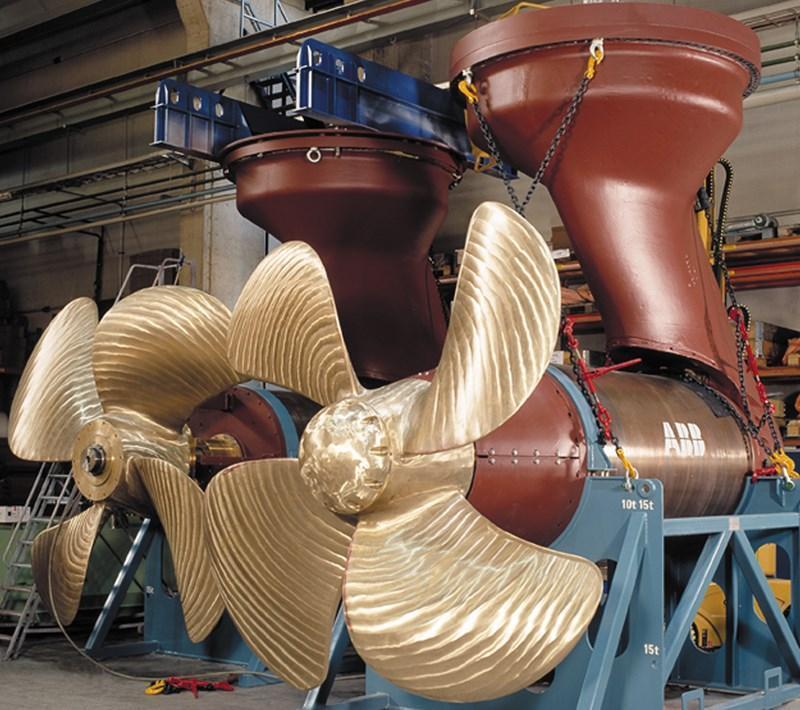
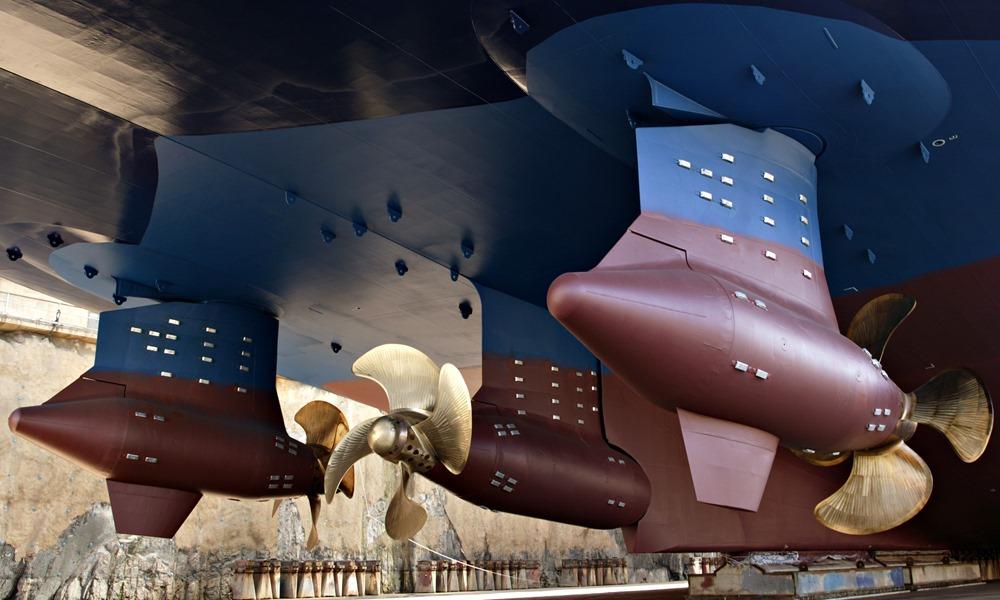
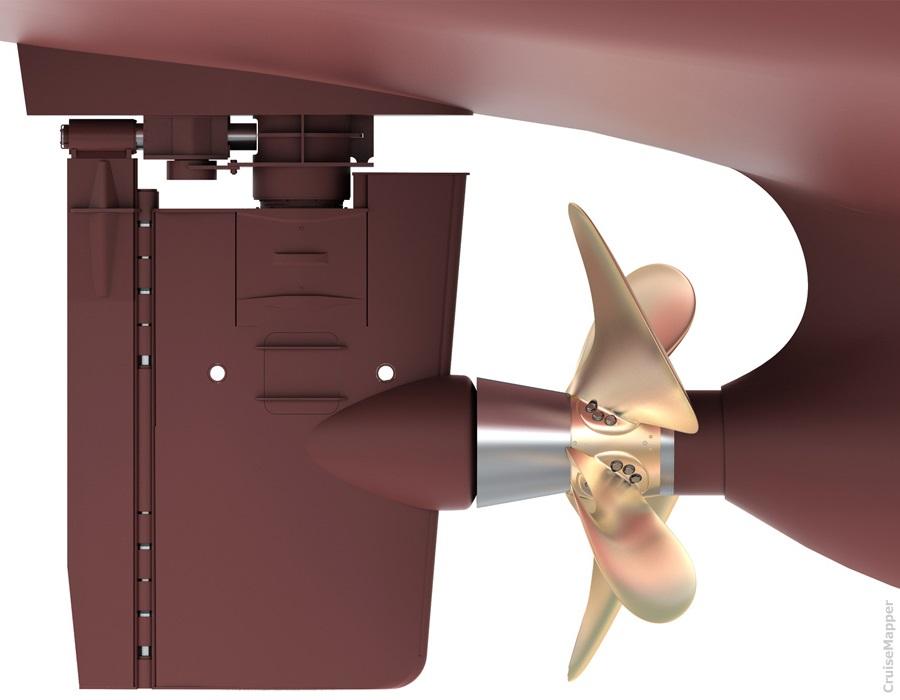
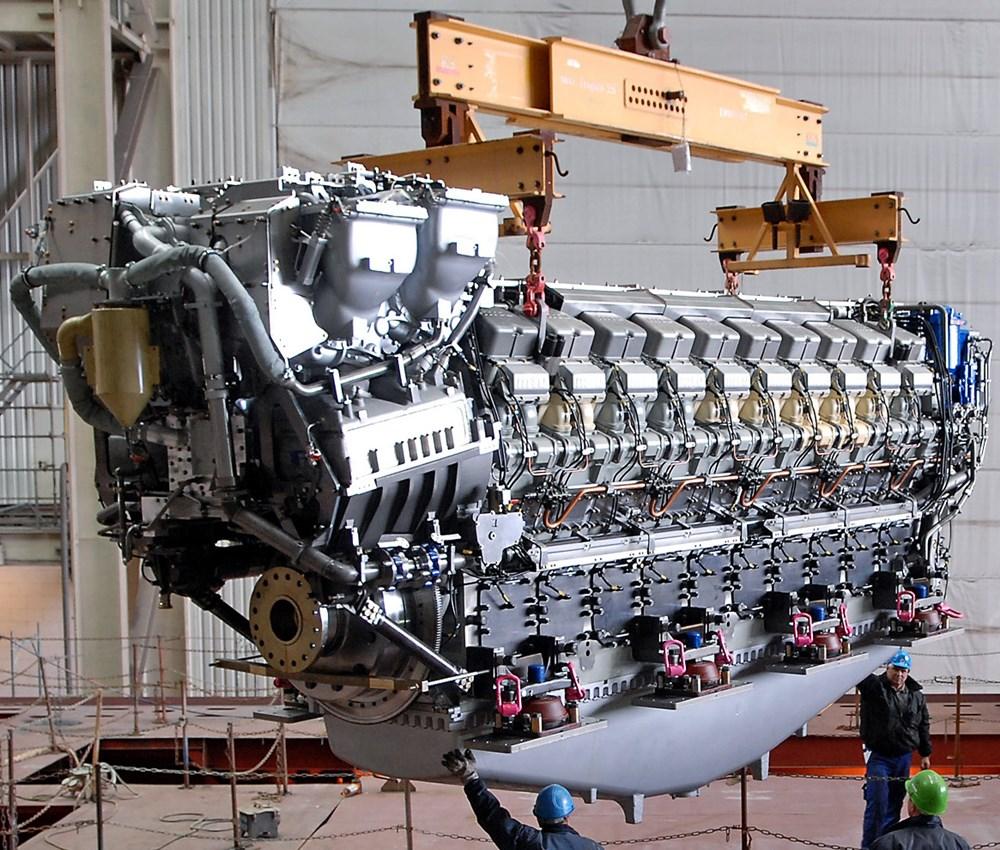
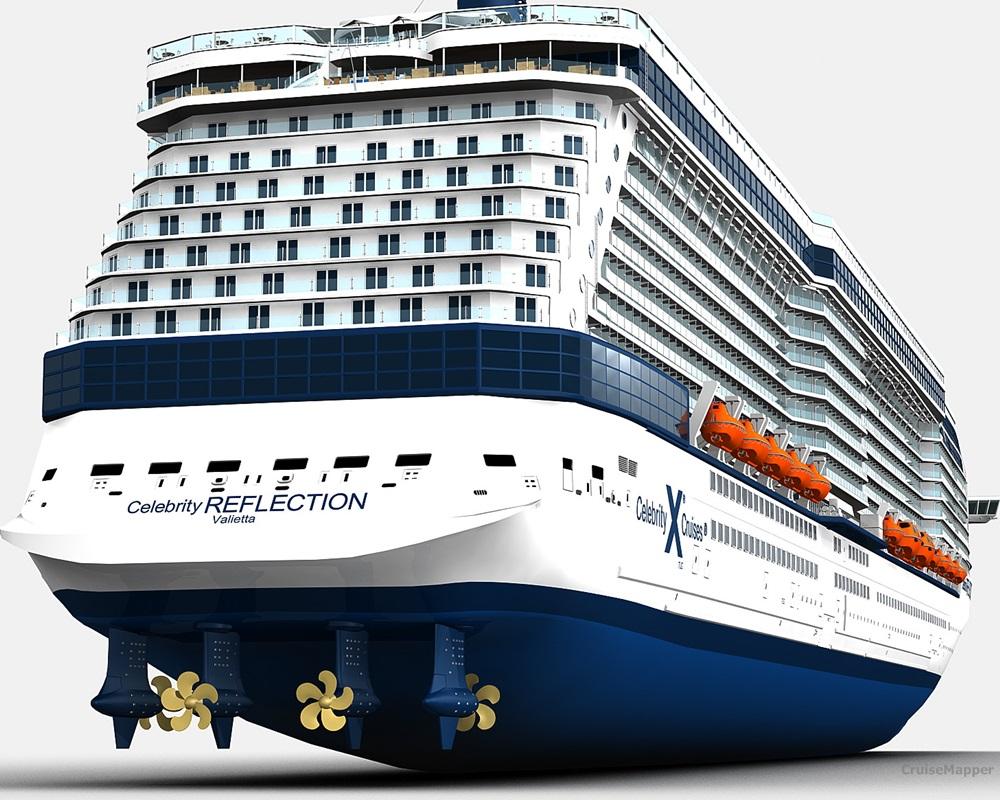
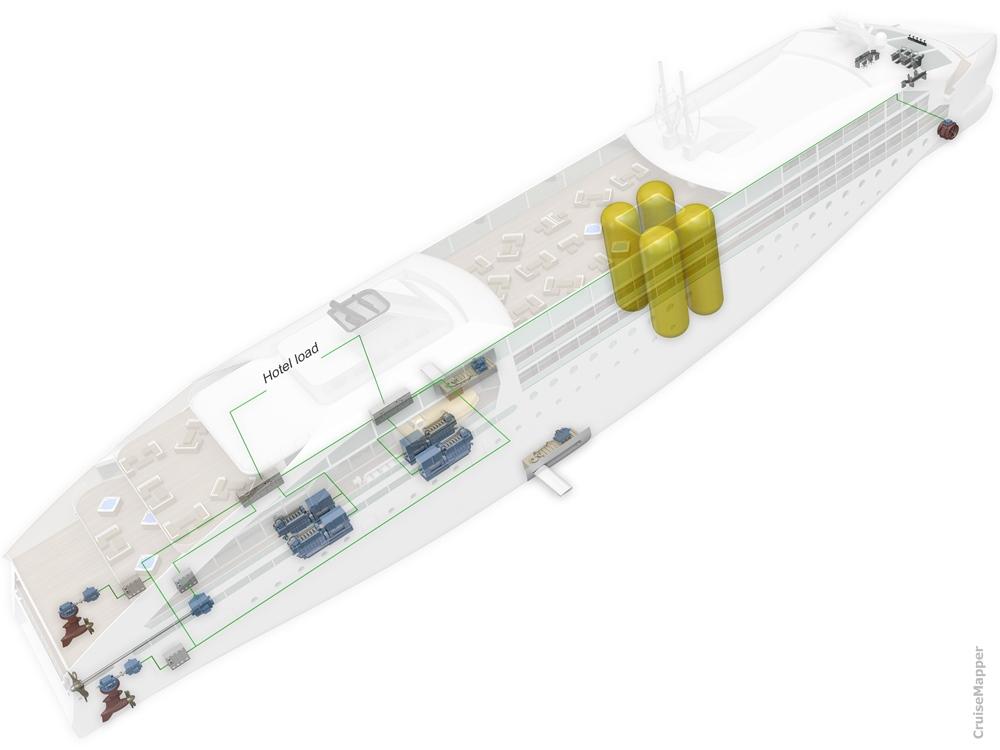
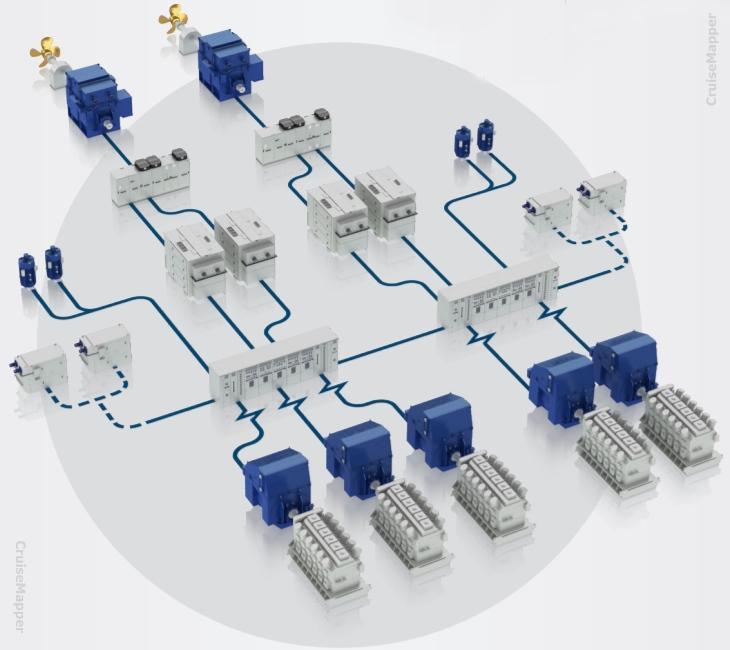
IMAGES
COMMENTS
Step on board the 162.5m Eclipse - the second largest superyacht in the world. Designer Terry Disdale talks us through the four and a half years, nine decks and 162.5 metres of the world's second largest superyacht. Terry Disdale didn't set out to design the biggest superyacht in the world. "No one ever said to me, 'I want a 160 metre ...
M/Y Eclipse is a superyacht built by Blohm+Voss of Hamburg, Germany, the third longest afloat.Her exterior and interior were designed by Terence Disdale. The yacht is owned by Roman Abramovich, and was delivered on 9 December 2010.At 162.5 metres (533 ft 2 in) long [5] Eclipse was the world's longest private yacht until Azzam was launched in April 2013, which is 17.3 metres (56 ft 9 in) longer ...
Eclipse Type. Motor Model. Custom Sub Type - Year. 2010 Flag. ... Fuel Type. Diesel Manufacturer - Model. 20V 1163 TB93 Power - ... Equipment Generator - Stabilizers - Thrusters - Amenities - Expand. Build Team. Yacht Builder Blohm + Voss No profile available. Naval Architect Blohm + Voss
The plush interiors of the Eclipse megayacht.Via Charterworld Abramovich's floating asset can travel up to 6,000 nautical miles at 21 knots before refueling. According to eSysman SuperYachts, the wealthy tycoon allegedly spent no less than $2.2 million (41 million Turkish Lira) on a single refuel.Filling up the vessel with a 1,000 tons of fuel would also have taken no less than 18-24 hours ...
The 162.5m long and $1.2 billion beauty, yacht Eclipse is the world's largest and most expensive yacht in the world. Proud owner of this beauty happens to be a Russian businessman who also owns Chelsea Football Club- Roman Abramovich. ... Featuring 1,000,000 litres of fuel tanks, Eclipse can travel up to 6,000 nautical miles at 21 knots ...
Abramovich's 553-foot-long flagship is The Eclipse, estimated to have cost $700 million when built. After sanctions were initially dropped by the UK against Abramovich, his second "smaller" $600 ...
It also can carry 1 million liters of fuel in tanks and can travel up to 6000 nautical miles at the rate of about 21 knots before it needs to be refueled. The boat can also store nearly one fifty thousand liters of fresh water on board. ... History of the Eclipse Yacht. As mentioned before the yacht is owned by Roman Abramovich, a Russian ...
Get the latest Eclipse Yacht specs, tests and reviews featuring models, specifications, available features, engine information, fuel consumption, and information resources. BoatingWorld Discover the World of Boating. Your Ultimate Boating Resource ... Boat Reviews. Boat Reviews Overview of the 2024 Sea-Doo RXP-X 325.
The Eclipse yacht owned by Roman Abramovich came to the Port of Gruz to fill up on fuel. It seems that around 750 tons were ordered, which is more than a half of the capacity of the fuel tank. The cost - around million euros - reports Dubrovacki.hr. Meaning that by the time the Russian's yacht was half full Croatia had earned 250,000 Euros ...
The Eclipse yacht is one of the most iconic and luxurious superyachts in the world. Known as the "USD 1.5 billion yacht", it was rumored to have cost an exorbitant amount. However, according to sources, the original contract price was around EUR 550 million, or USD 700 million, which is far less than the speculated amount.
On average, a yacht might use between 20 to 100 gallons of fuel per hour. Smaller yachts, such as those around 40 feet, tend to be on the lower end of the scale, consuming about 20 to 40 gallons per hour. Larger vessels, which are over 100 feet, can consume significantly more, sometimes exceeding 100 gallons per hour, especially at higher speeds.
The luxury motor yacht ECLIPSE was built by Couach and delivered to her owner in 2005, she later underwent a refit in 2020. ... Fuel consumption (max) 567.8lph / 150gph: Range (max) 1852km / 1000nm: Engine: 2 x MTU V 16 motors of 2400 CV each 2 x Kohler 55 generators: Hull: Monohull: Flag: Jamaica: Launched: 2005:
Fuel prices can vary but typically costs between €0.80 and €1.30 per litre. Yacht charter, sales and management company West Nautical added: "Fuel costs should be at the top of any yacht owner and captain's minds for two reasons: to minimise costs as well as reduce the environmental impact of burning unnecessary fuel.
3 hrs x 130 gph = 390 gallons. All that is left to do now is add up the total amount of fuel needed and multiply the number with the price per gallon. (7500+390) x $3,5 = $27615. In this example, the final cost of your will set you back a little bit more than 27 thousand dollars.
Eclipse is a yacht made of a steel hull and a aluminium superstructure: those characteristics allow wide spaces but also a more stable anchoring. Propelled by two caterpillar engines, she sails comfortably at 12 knots and can reach a maximum speed of 13 knots. She has as well a range to up to 4,376 miles thanks to her fuel tanks of 56,800 liters.
The efficiency of boat fuel is measured in pounds of fuel that are used in an hour per horsepower. In order to be able to read the calculation right, any boat owner should know that gasoline is almost 6.1 pounds per gallon while diesel is 7.2 pounds per gallon. Usually, if you consider that all sea conditions are pristine, the fuel consumption ...
Re: Fuel consumption - real world numbers. We also sail, which keeps the fuel bills mighty low. Two, 2 week sailing vacations in the BVI ..,,, We used 7 to 7.2 gallons of fuel for each of the two weeks. Most of that charging up the batteries every day ( 1400 rpm). We motored a few times for short passages ( 2300 rpm).
Scenic Eclipse with Svitzer Tugs in Hook of Holland.. Scenic Group founder and Chairman Glen Moroney decided to build Scenic Eclipse after being inspired by Paul Allen's Octopus yacht. [2] The construction of the Scenic Eclipse began in 2017 but was delayed numerous times due to the bankruptcy of the building yard. [3] The vessel finally entered service in August 2019. [4]
10 facts about the superyacht Azzam. 1. Azzam was never conceived as the world's largest superyacht. The design was to be high speed and accommodate a certain interior plan and number of guests, but it was originally envisaged as 145 metres overall. As the need to optimise the structure, and create space for complex engine systems, fuel and ...
Welcome to the West Nautical Fuel Calculator. HOW TO USE: To plot points on the map, click with your mouse - this will automatically update the distance table. Then enter the speed, fuel consumption, and fuel cost to determine the total cost of the trip. Example 1: A fast 30m yacht cruising at 20 knots ( Lady Amanda) will consume roughly 400 ...
CREW 2. CRUISING SPEED 20 Knots. FUEL CONSUMPTION 220 Litres/Hr. MOTORIZATION 2 X CAT 1015 HP. ECLIPSE is an Azimut 62S available for charter in Amalfi Coast, Sicily, Sardinia. The yacht features 2 cabins for 4 guests with 2 crew. Contact us for rates!
Roman Abramovich's 163-metre Eclipse, one of the world's largest superyachts and estimated to cost more than $1bn, found refuge in the Turkish port of Marmaris. Long before the latest Ukraine ...
In 2012, TUI used 54,463 tons of fuel, including 9,732 tons LSFO (low sulfur fuel oil), 40,880 tons HFO (heavy fuel oil) and 3,851 tons MDO (marine diesel oil). Fuel consumption was 0,367 tons per nautical mile. All new TUI ships are built to the latest standards with environmentally-friendly marine technologies.